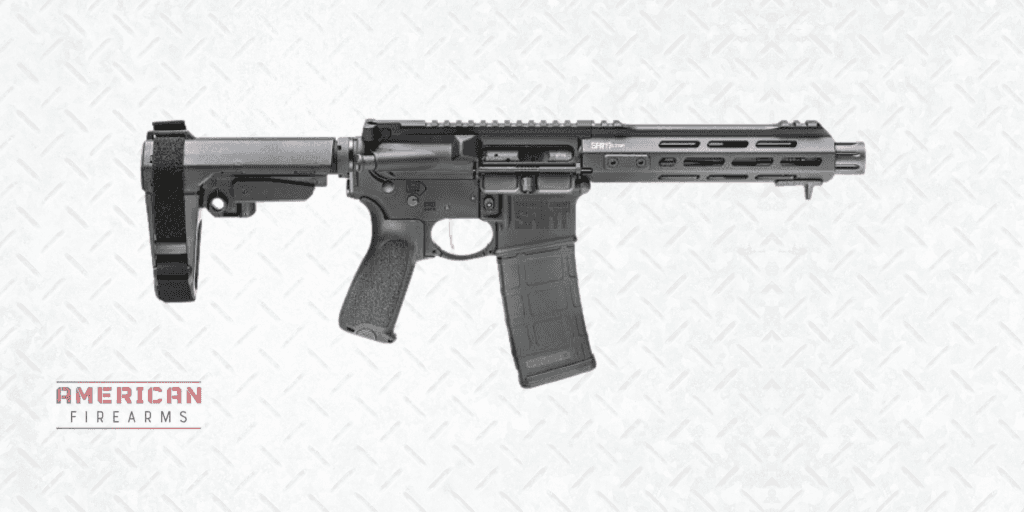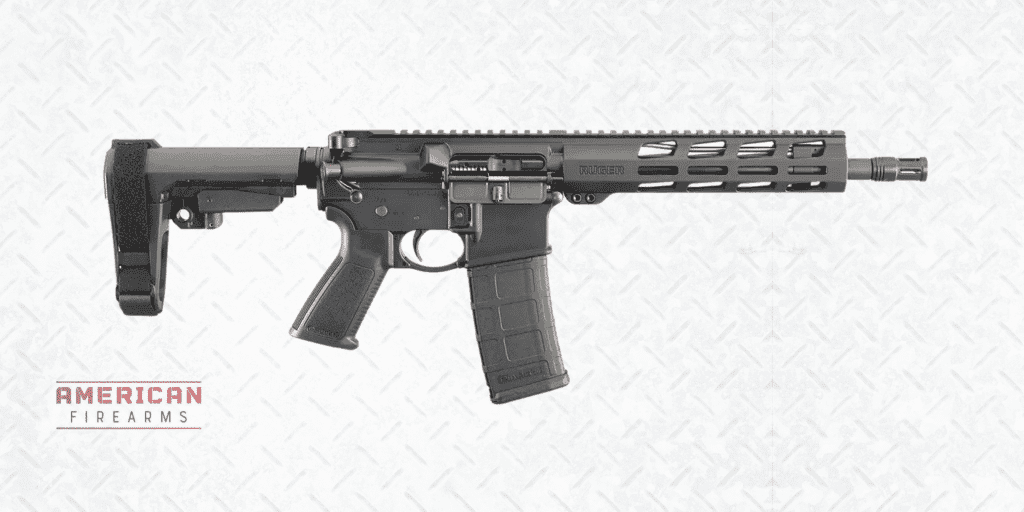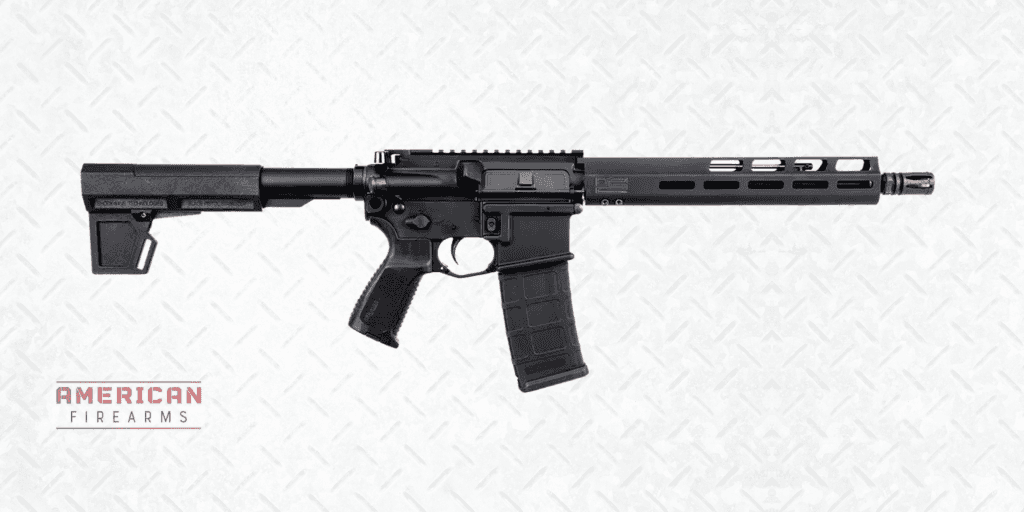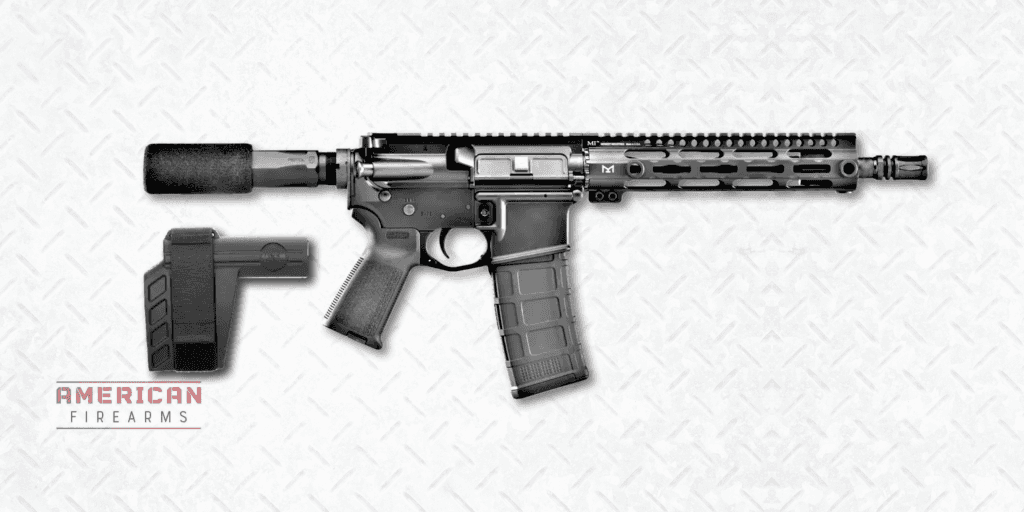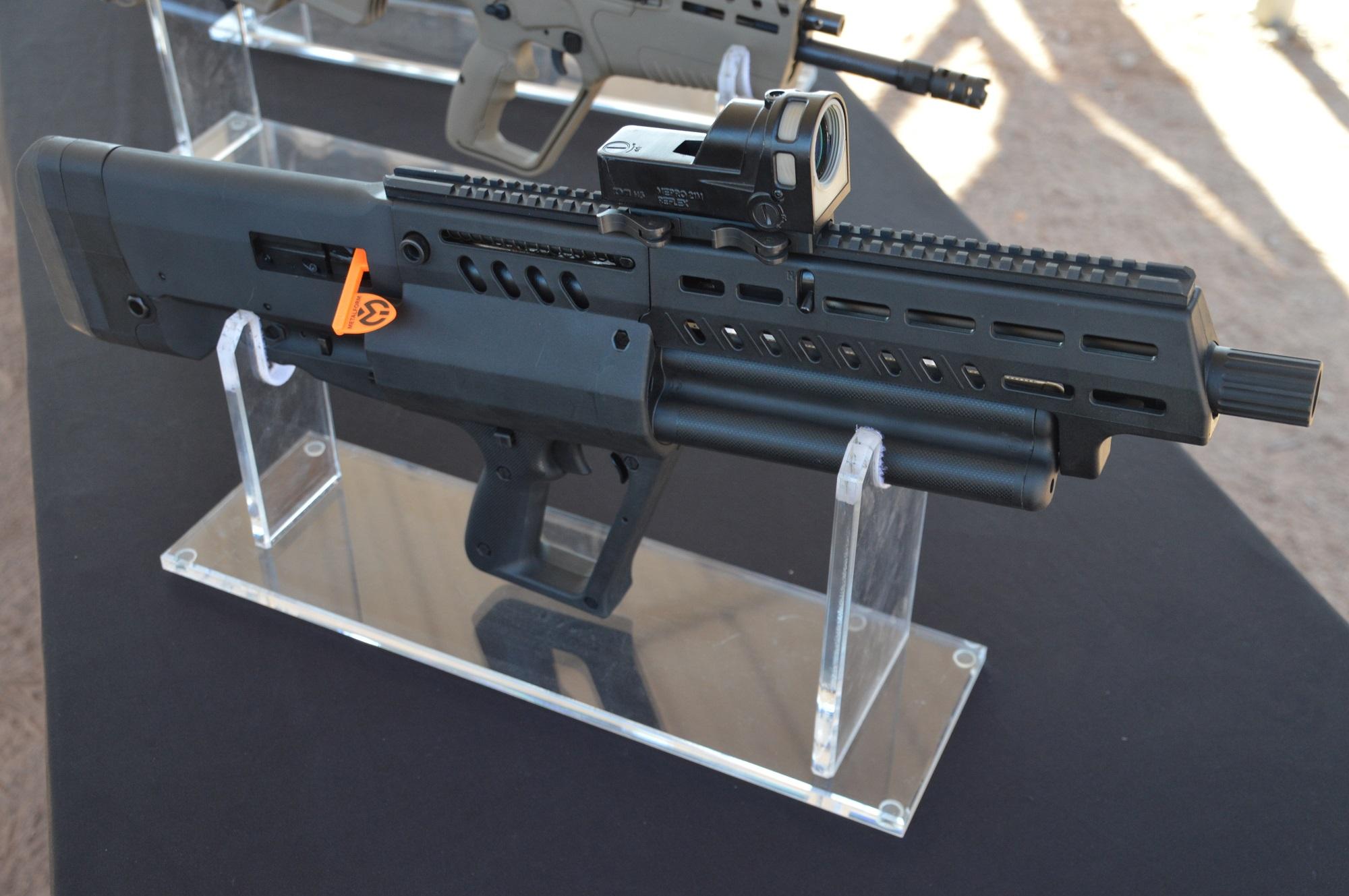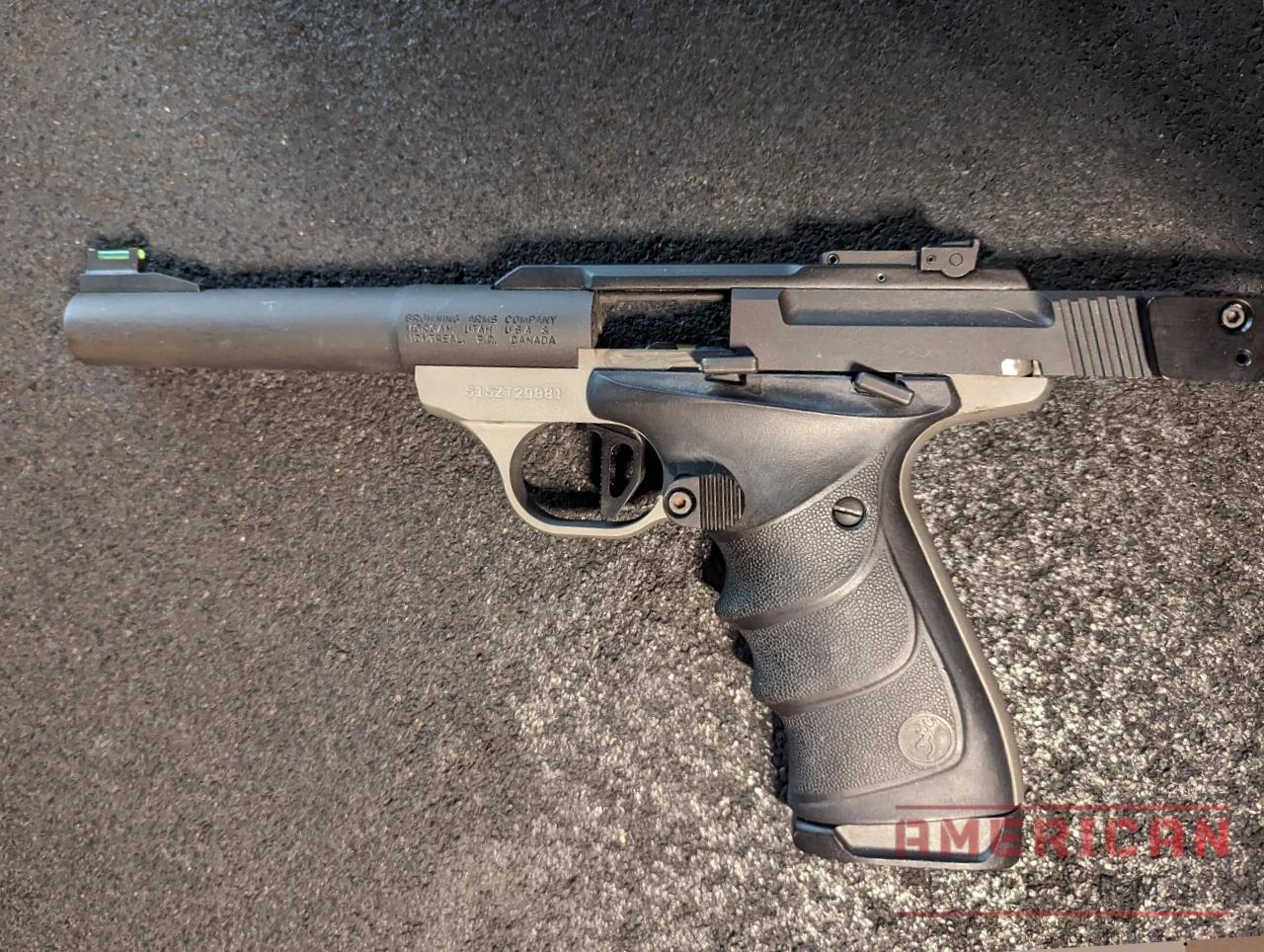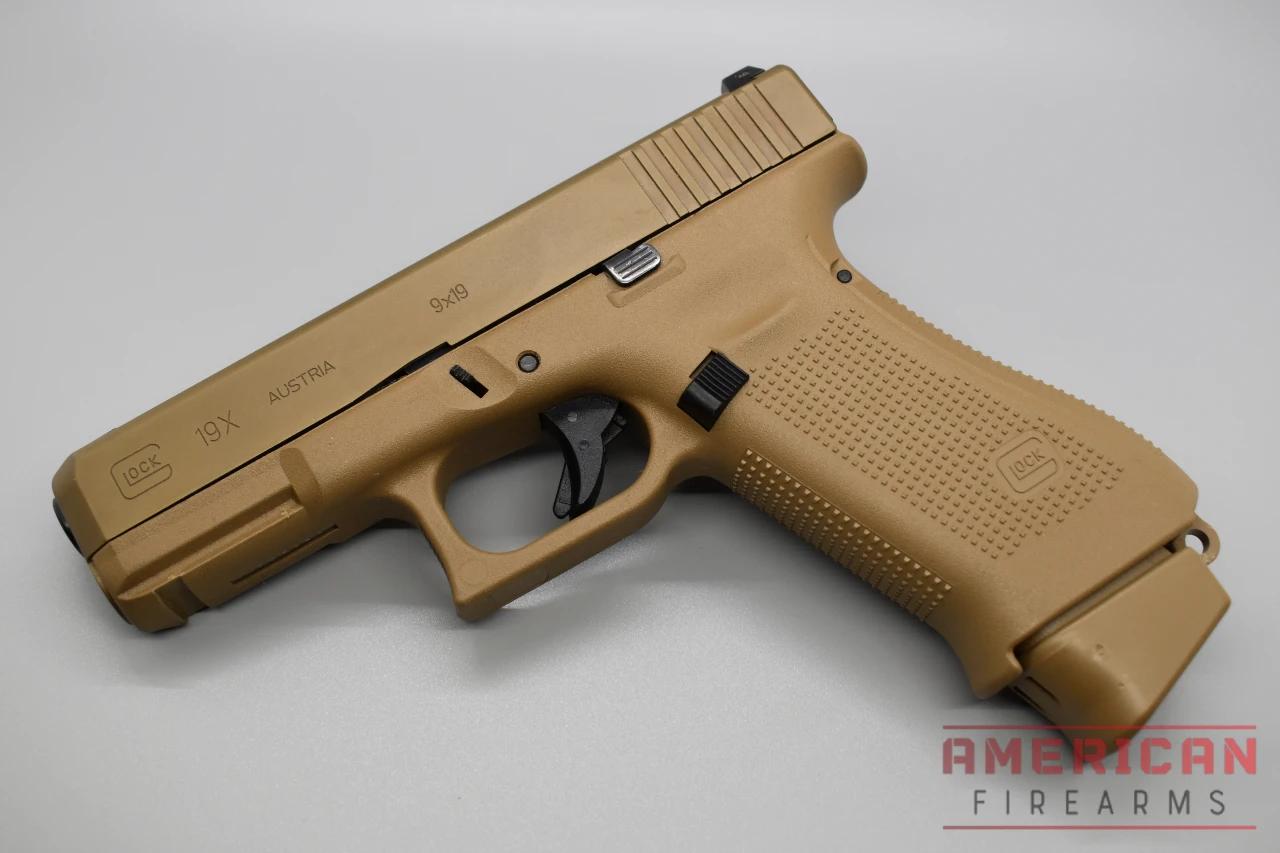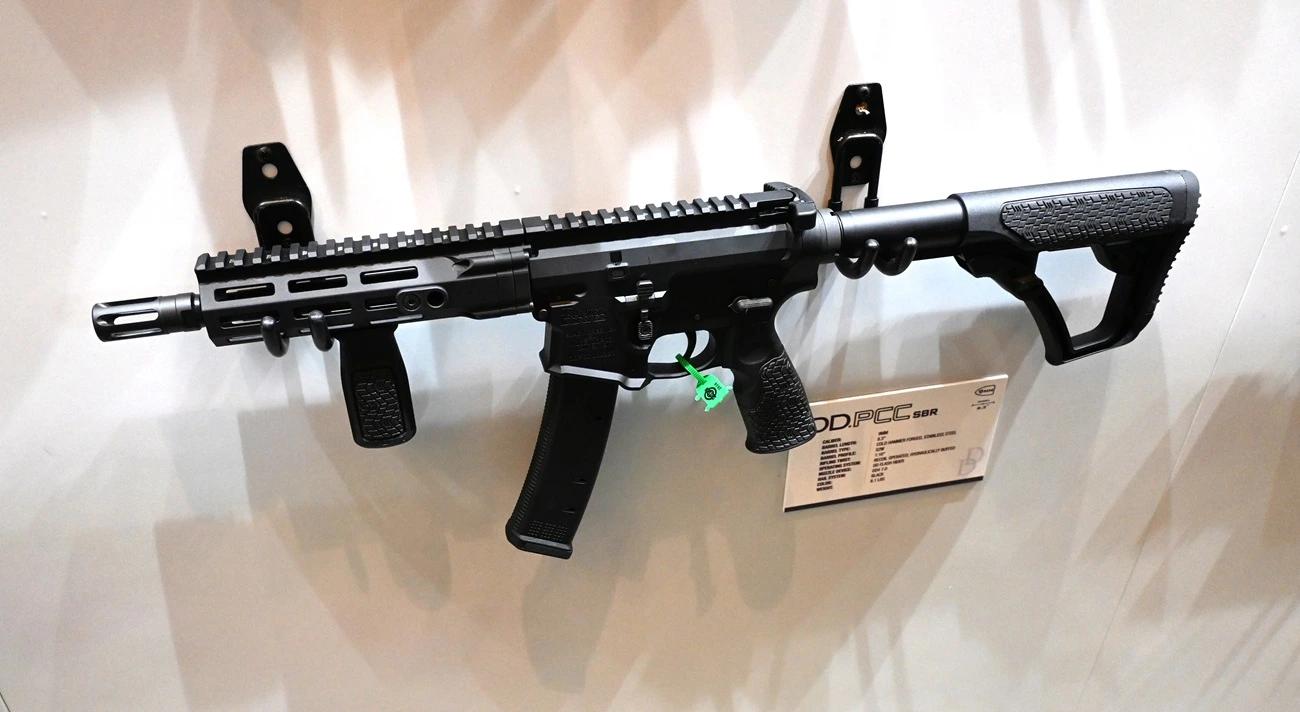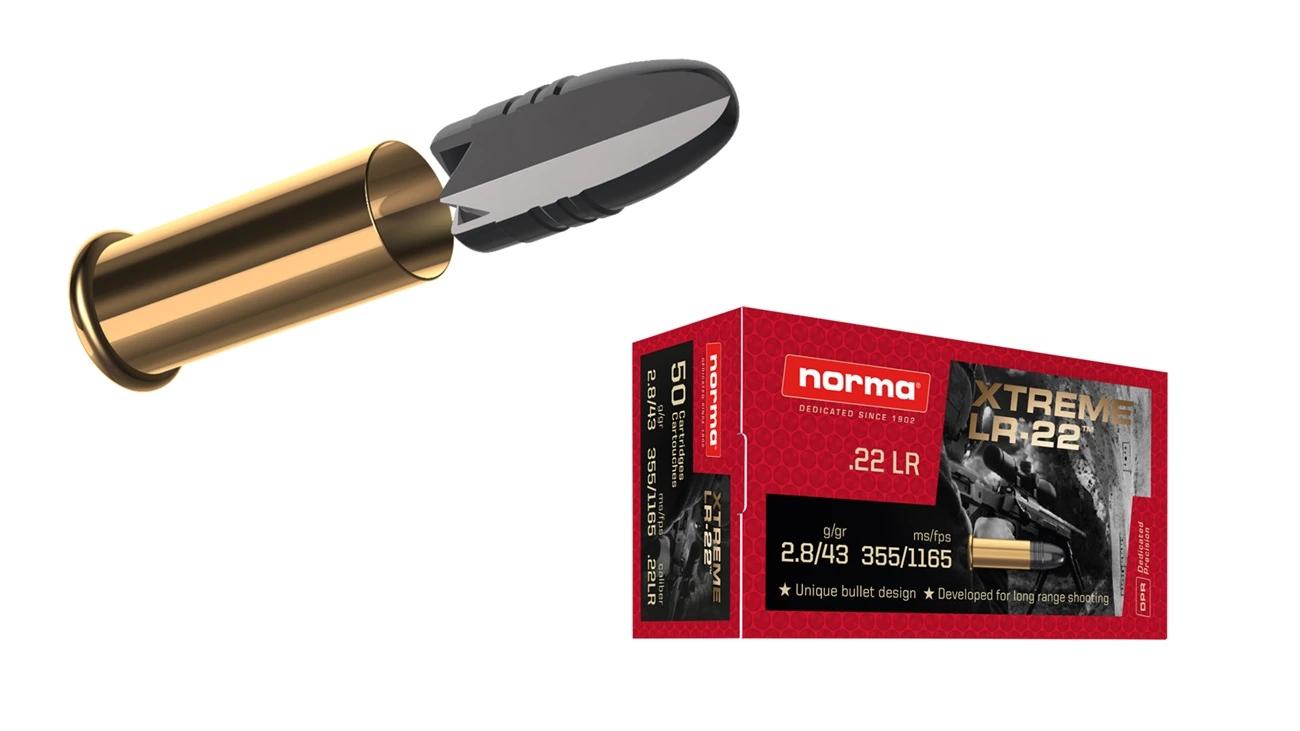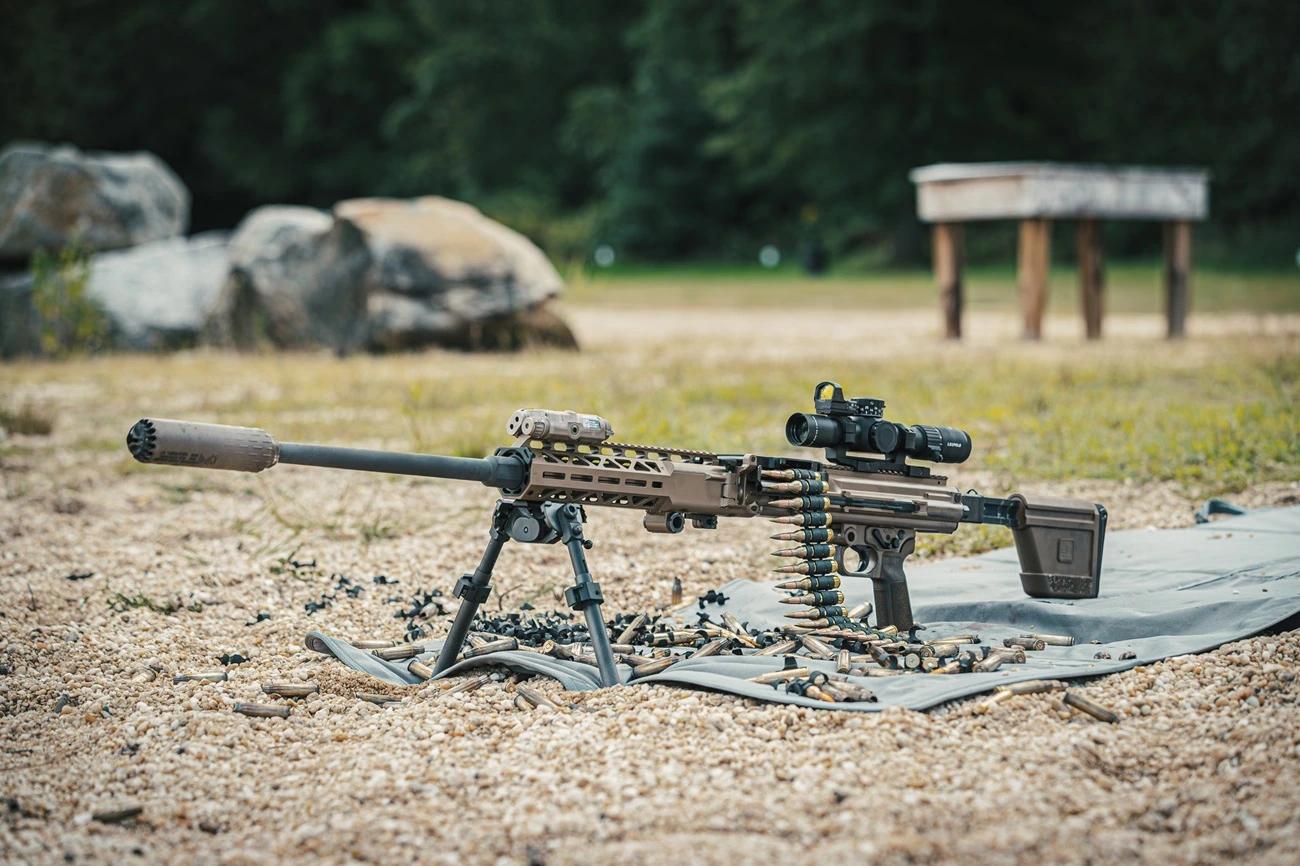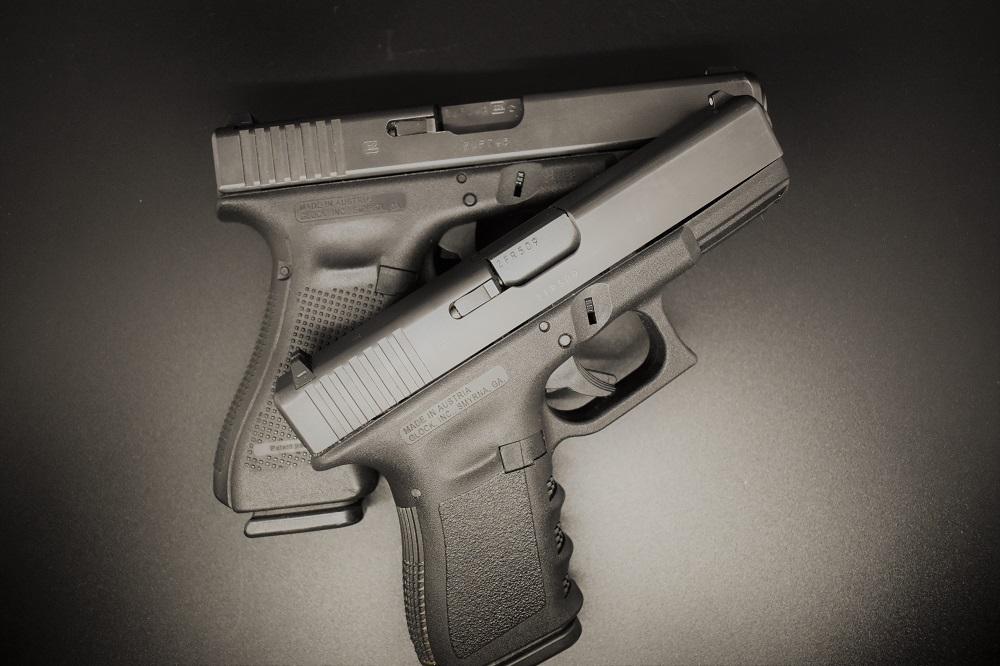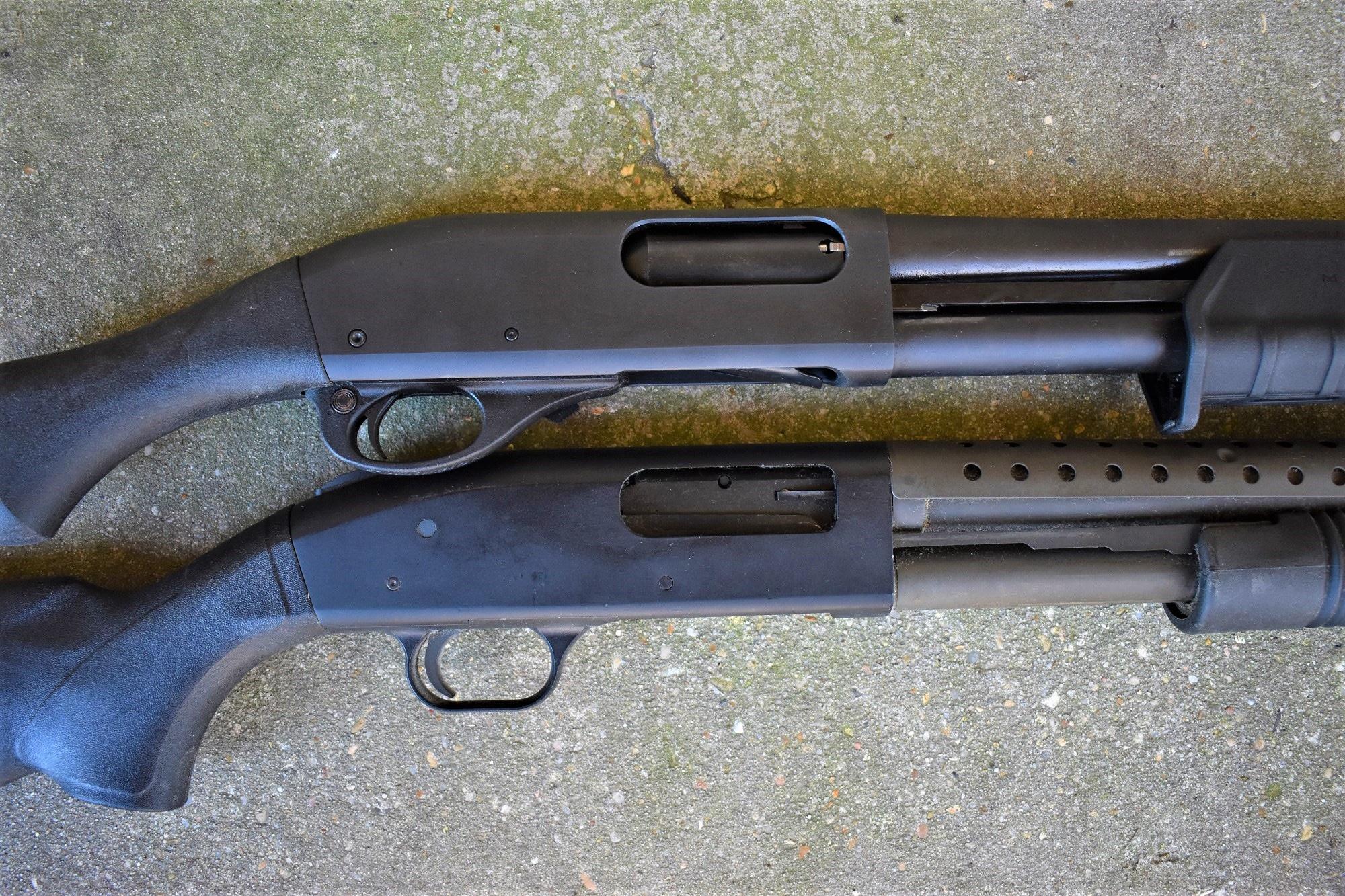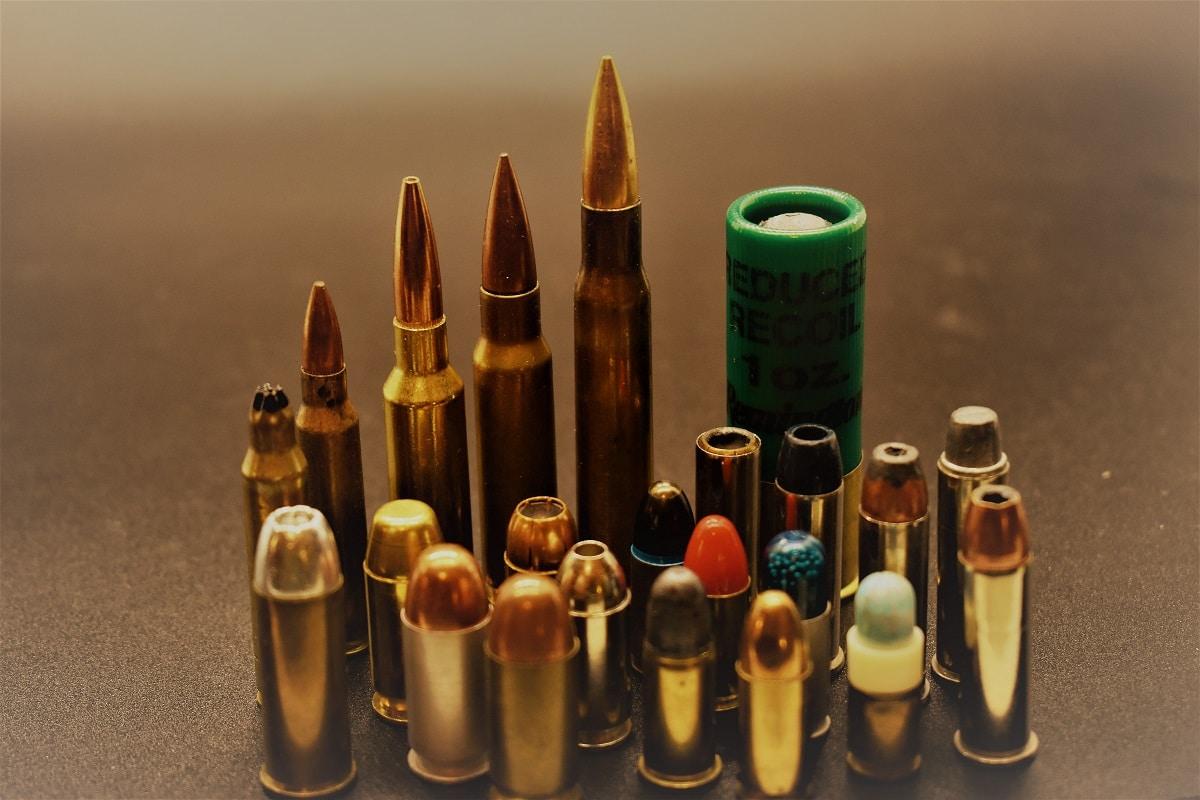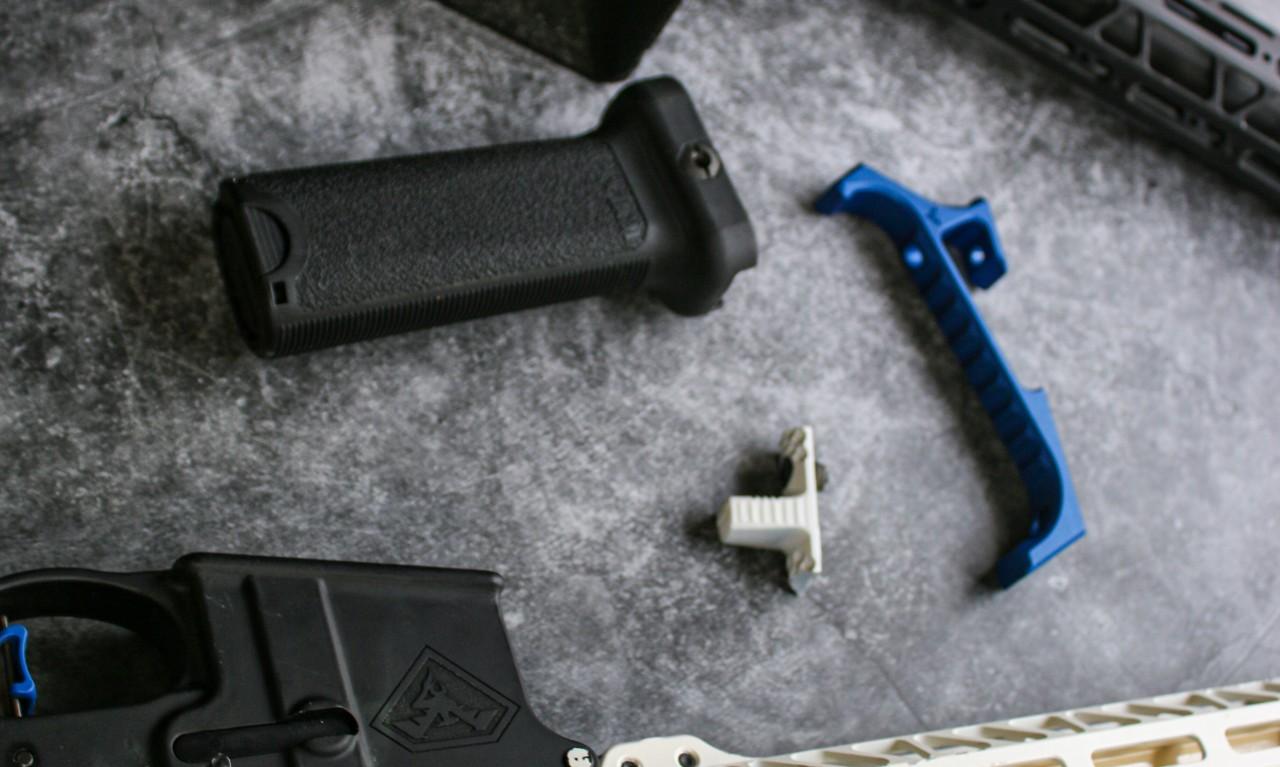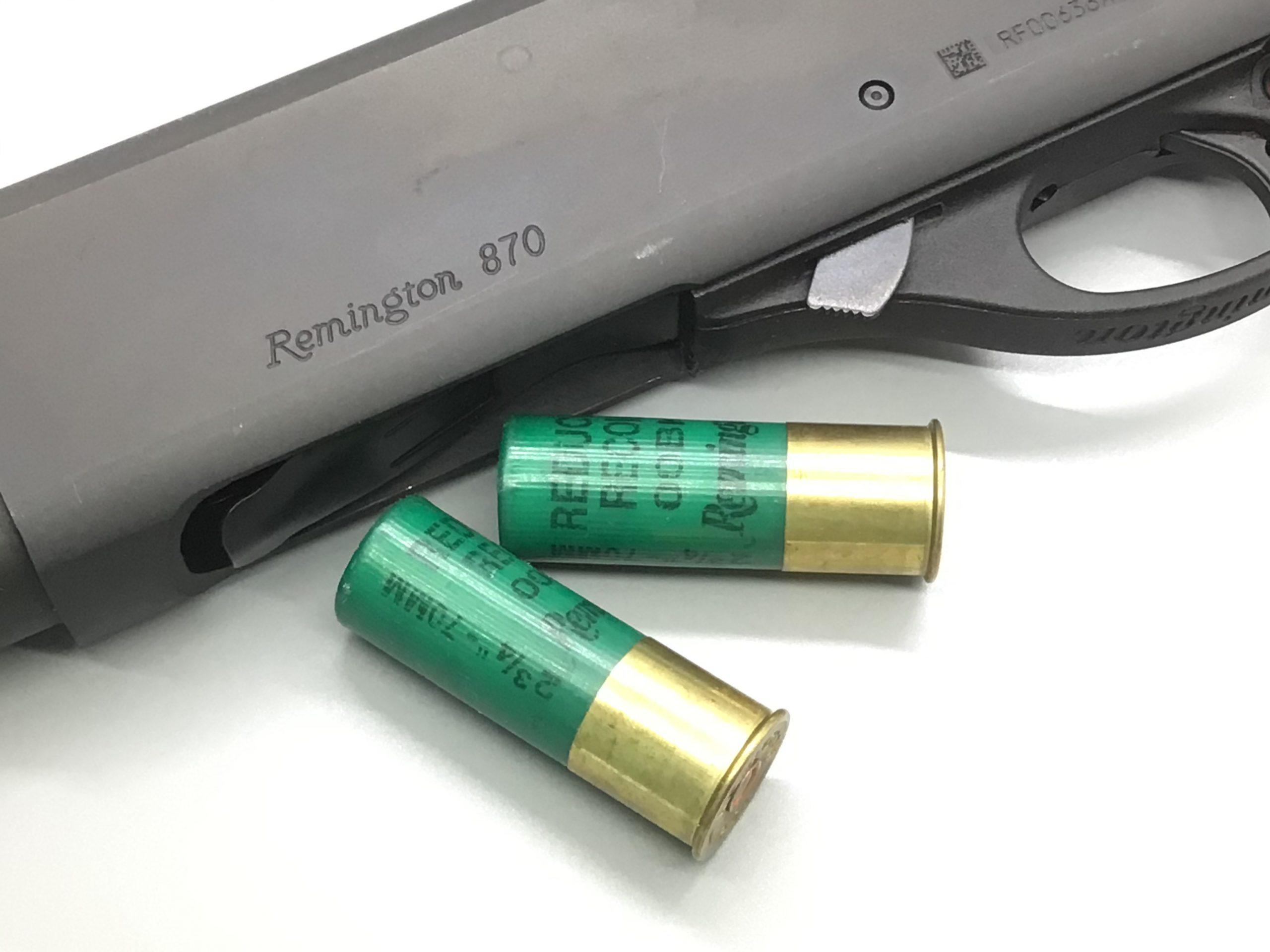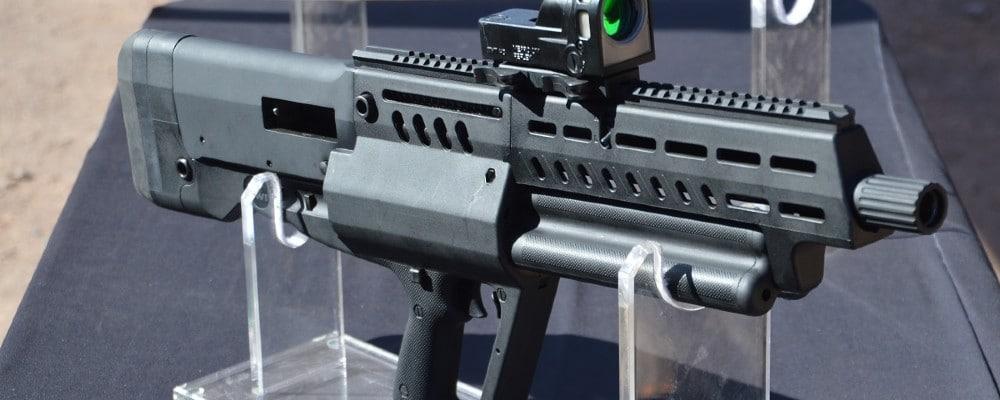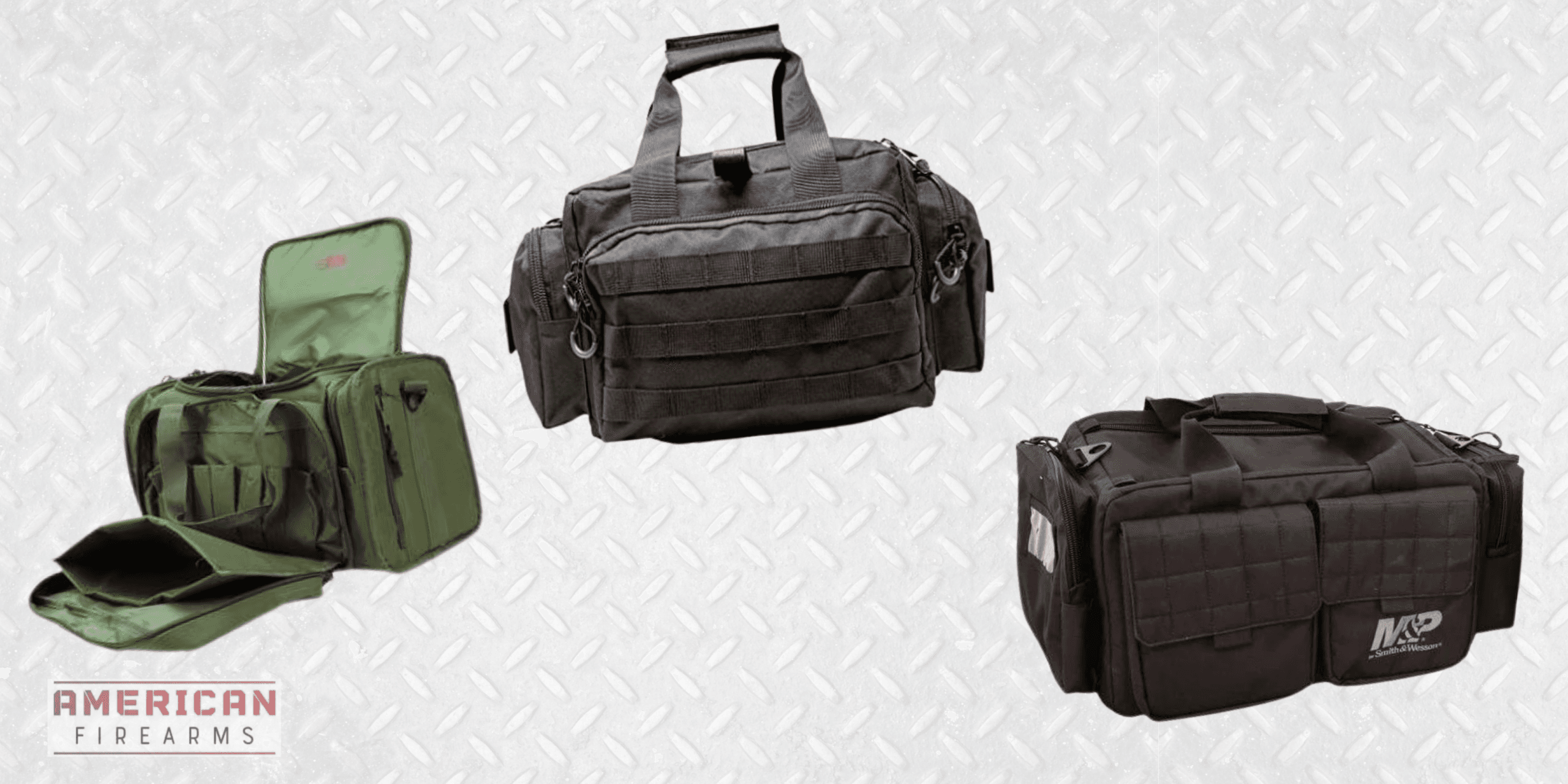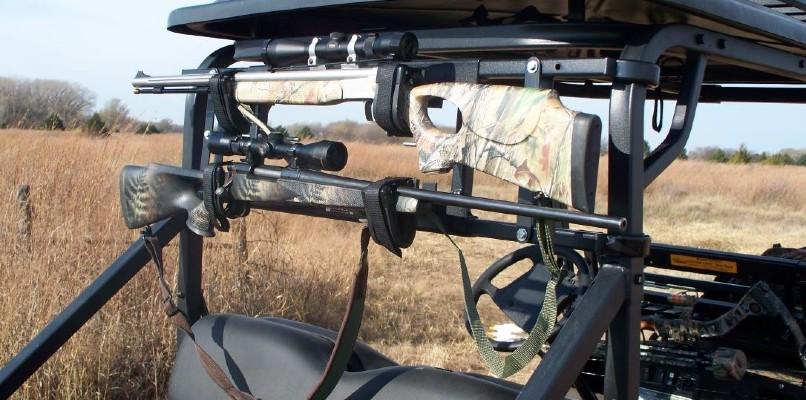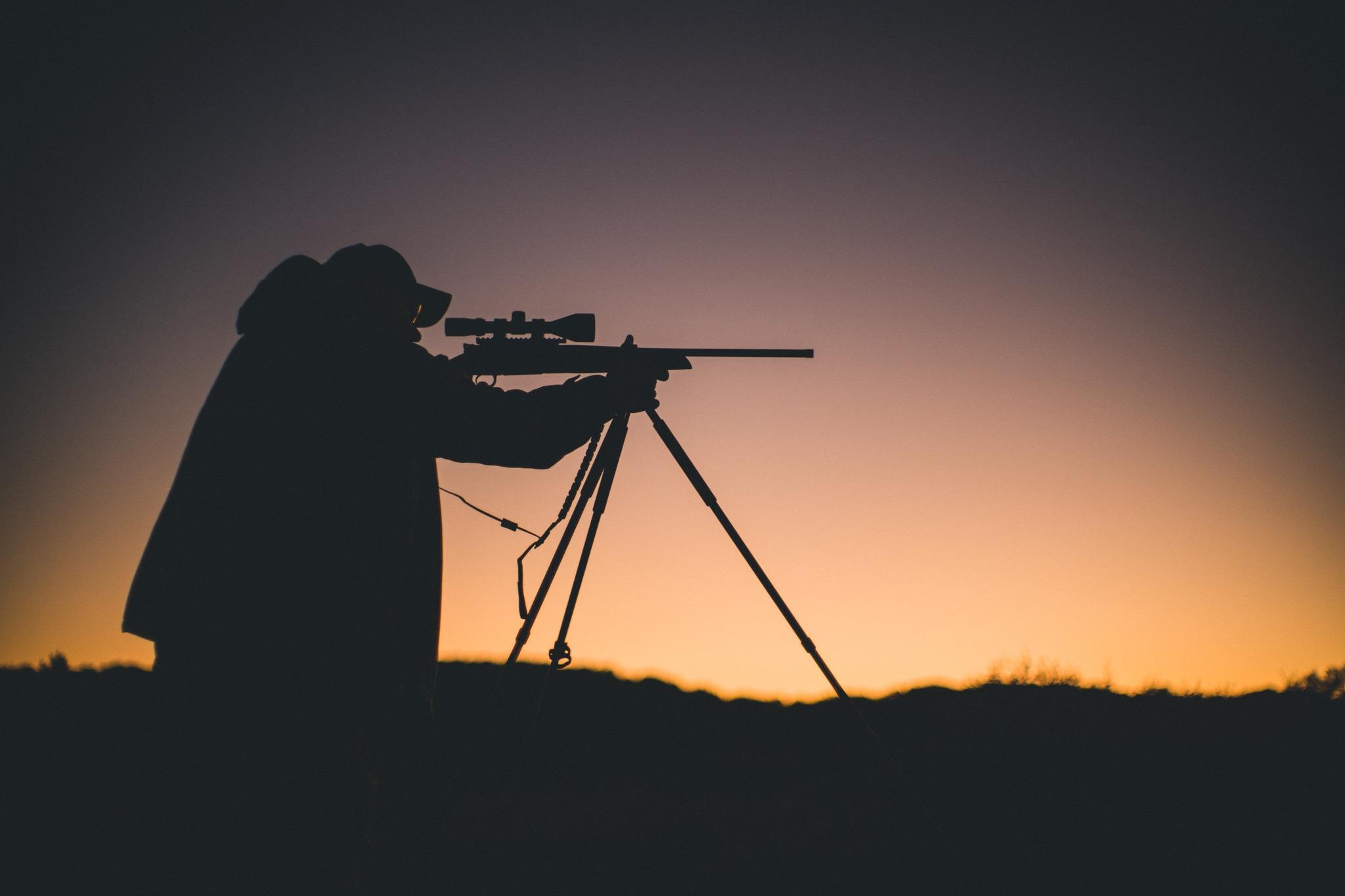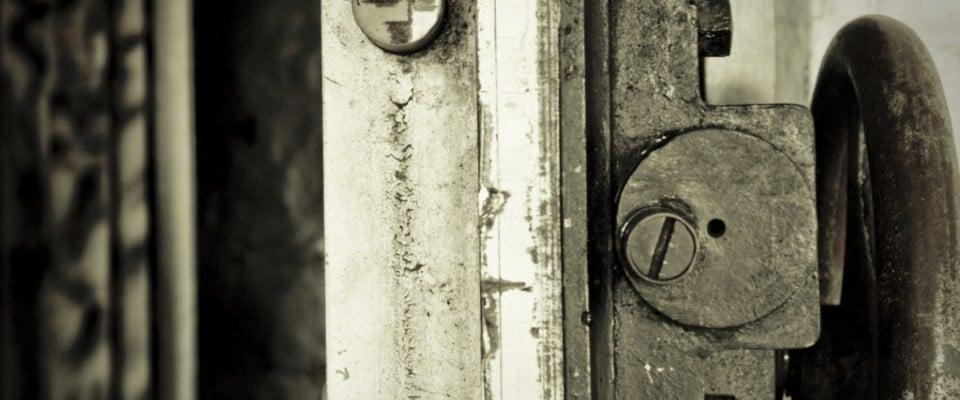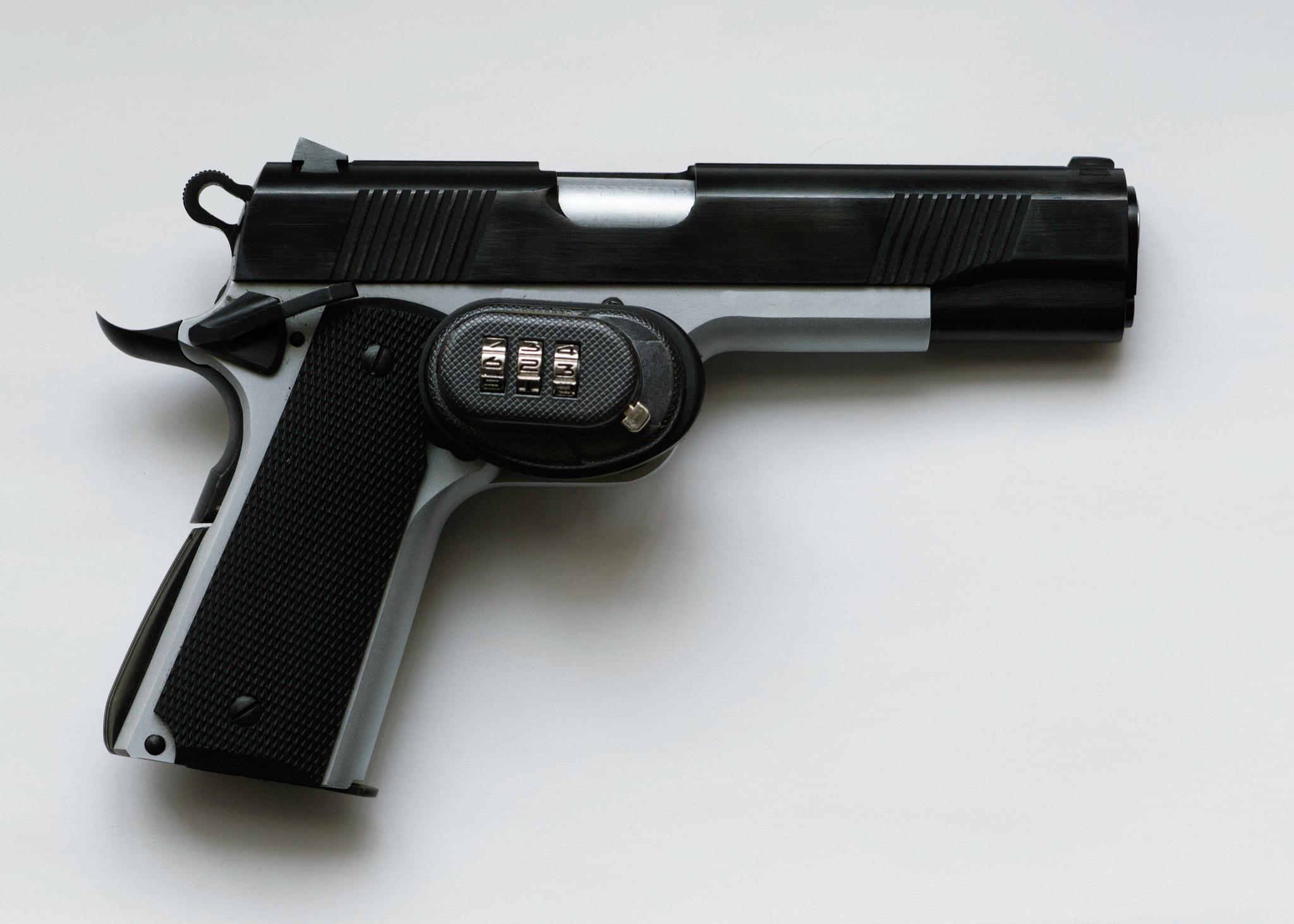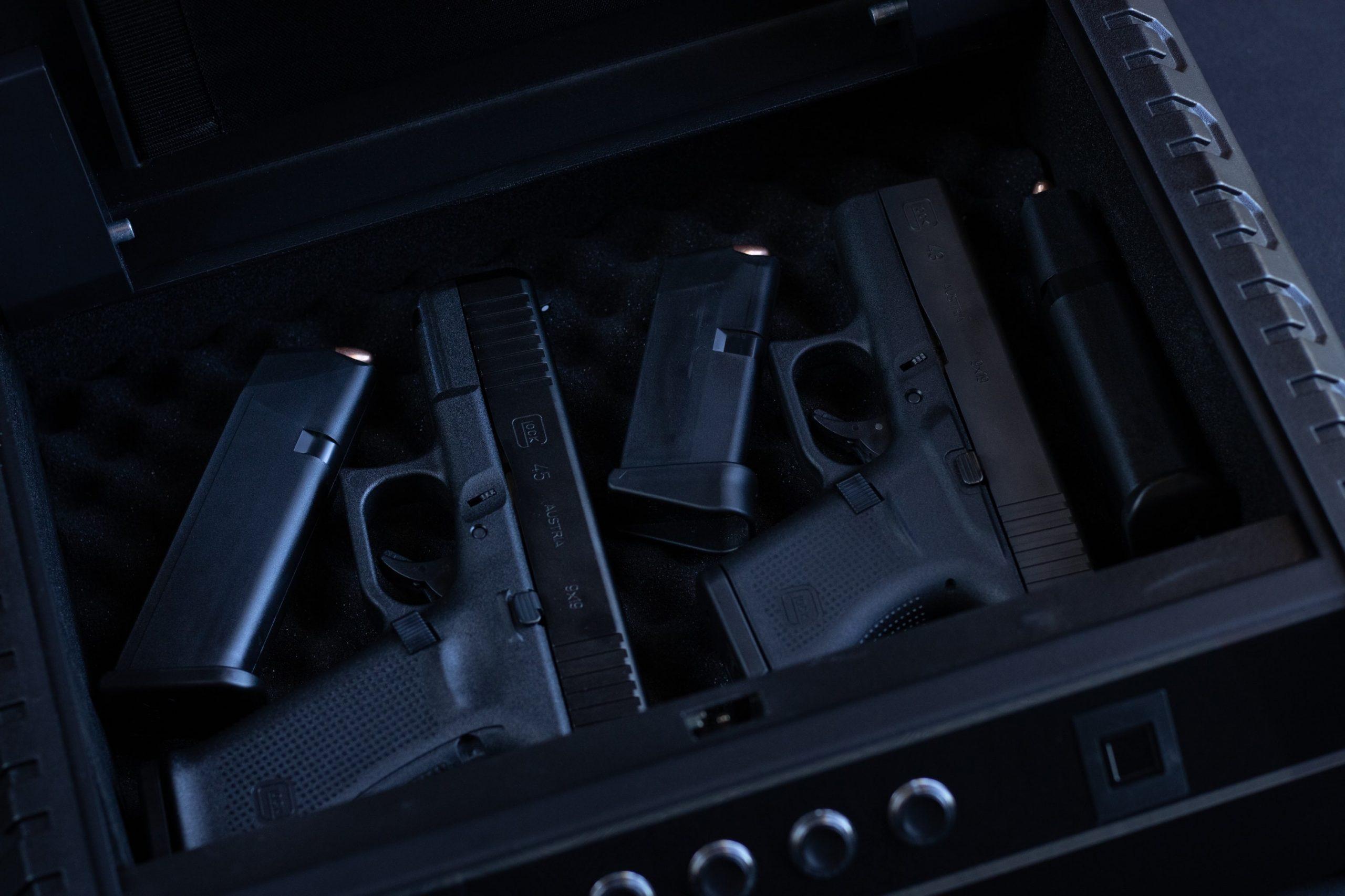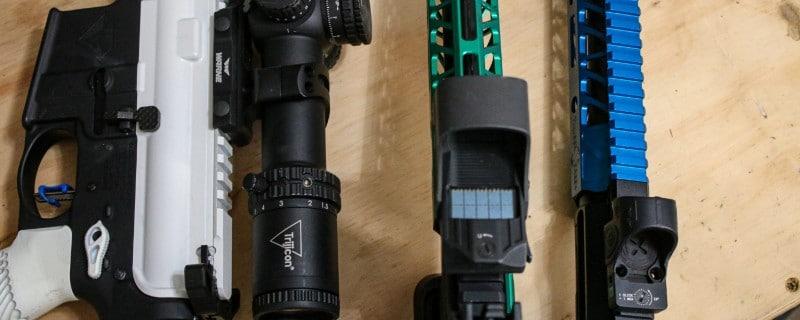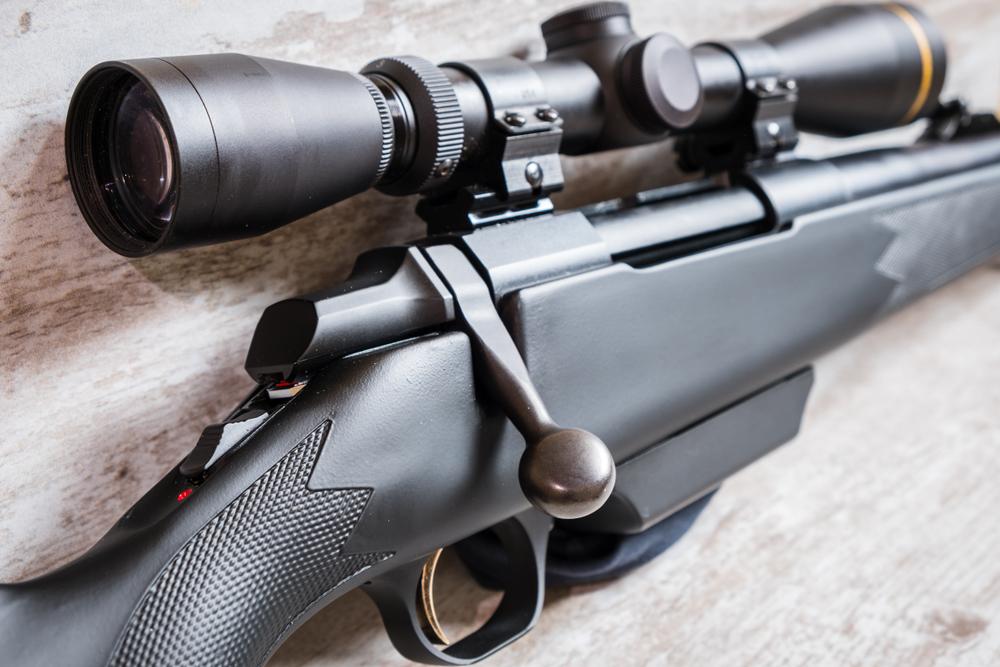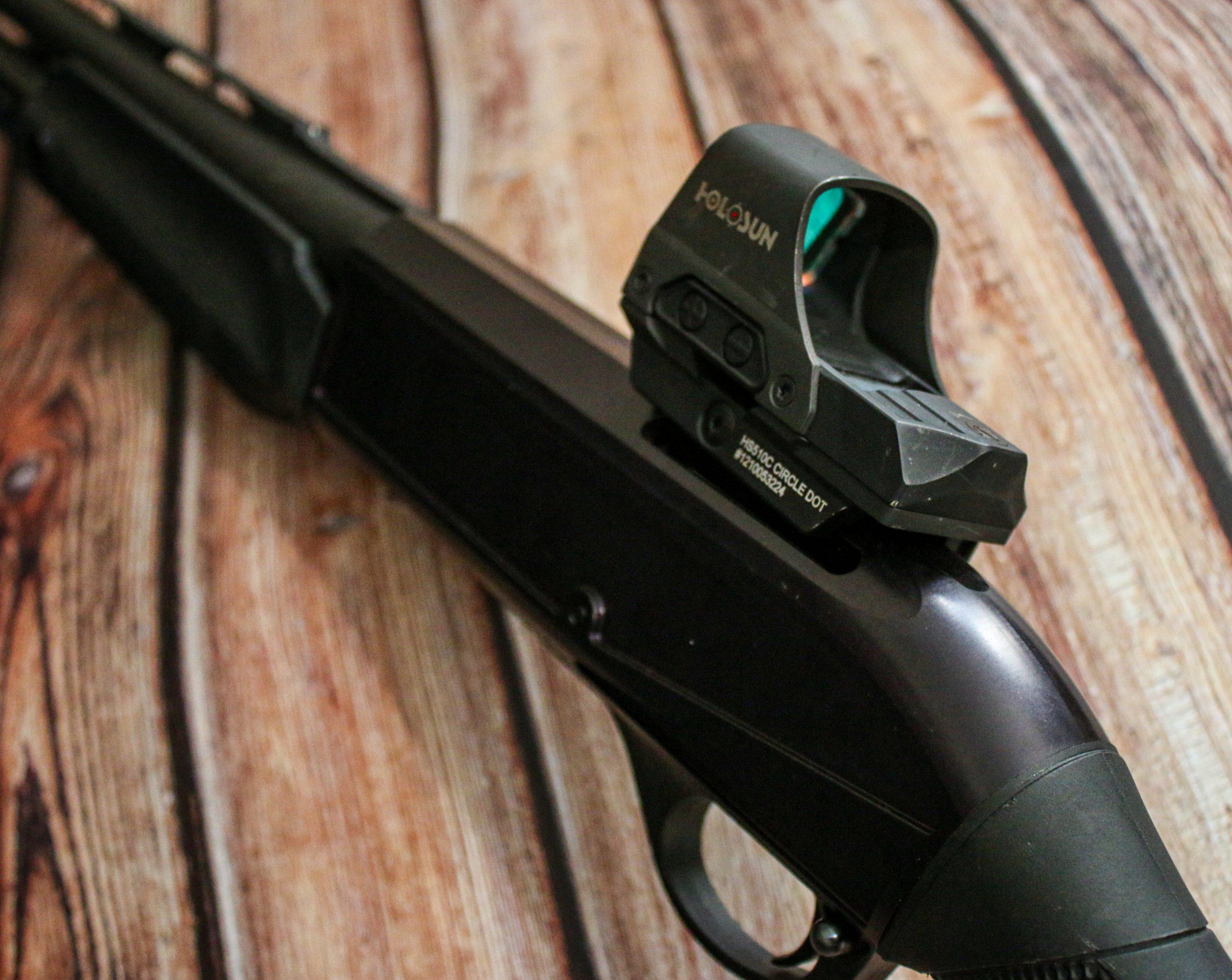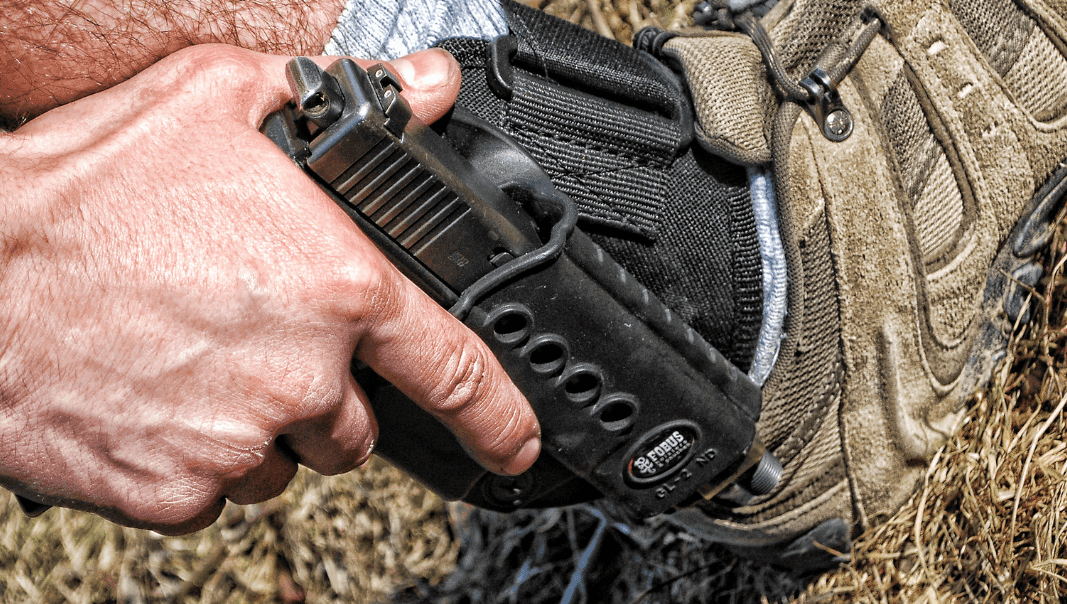Best AR-15 Pistols 2025 Tested: Complete Buyer’s Guide
Written By
Kenzie Fitzpatrick
Competitive Shooter
Edited By
Michael Crites
Licensed Concealed Carry Holder
Share:
Products are selected by our editors. We may earn a commission on purchases from a link. How we select gear.
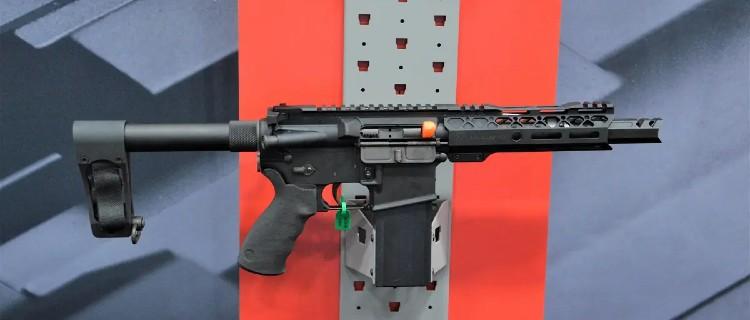
Updated
Jun 2025
The AR-15 platform, originally designed by Eugene Stoner in the late 1950s, has undergone numerous transformations over the decades, adapting to the ever-evolving needs of firearm enthusiasts and professionals alike.
Among the most popular transformations was the emergence of the AR pistol variant, which capitalized on the platform’s versatility and inherent adaptability.
While the AR-15 rifle has its roots in military applications, the AR pistol has carved out its niche in the civilian market, offering a compact and powerful alternative to its longer-barreled brethren.
But to truly appreciate the AR pistol’s significance, one must delve into its origins and the factors that led to its rise in popularity.
You see, AR pistols aren’t as new as you might think. The 1970s saw the introduction of the Gwinn/Bushmaster 5.56mm NATO “Armpistol,” a precursor to modern AR pistols.
This innovative design, though not as refined as today’s models, showcased the potential of a compact firearm built on the AR platform. Interestingly, the Gwinn/Bushmaster was initially designed with aircraft pilots in mind, providing them with a powerful yet compact firearm that could be easily stored in tight cockpit spaces and used in emergency situations (and much more capable than Ithaca M6.)
The legal landscape, especially the National Firearms Act (NFA) and its implications on short-barreled rifles, further shaped the development and adoption of AR pistols. The introduction of stabilizing braces, like the SIGTac SB15 by Sig Sauer in 2013, revolutionized the AR pistol market, offering enhanced single-handed performance without the legal complications of a rifle stock.
In this comprehensive guide, we’ll explore the technical nuances, historical developments, and practical applications of AR pistols. From barrel linings to bolt carrier groups, and from the direct impingement system to gas-piston systems, we aim to provide a holistic understanding of this fascinating firearm variant, ensuring both novices and experts gain valuable insights.
In This Article
Why an AR pistol?
The AR pistol, while a relatively modern iteration, has roots that trace back to the earliest days of firearm innovation. Historically, the quest for compact yet powerful firearms has been a consistent theme, from the concealable flintlock pistols of the 18th century to the compact submachine guns of World War II.
During the Prohibition era, law enforcement officers and gangsters alike sought compact firearms that could be easily concealed yet packed a punch. The result was the widespread use of “Tommy guns” or Thompson submachine guns. These firearms, while larger than today’s AR pistols, showcased the demand for powerful, compact weapons that could be used in close-quarters combat.
Fast forward to the 21st century, and the AR pistol emerges as a solution to a similar demand. Here’s why:
- Adaptability: The modular nature of the AR platform allows for significant customization. Users can tailor their AR pistols to specific needs, whether it’s for home defense, sport shooting, or as a truck gun.
- Legal Landscape: With the complexities surrounding short-barreled rifles and the ATF’s regulations, AR pistols offer a way to enjoy the benefits of a compact AR platform without the legal entanglements. The introduction of stabilizing braces further blurred the lines between rifles and pistols, making AR pistols even more appealing.
- Technological Advancements: Modern ammunition, especially rounds like the .300 Blackout, are designed to perform optimally in short barrels, making them perfect for AR pistols. This wasn’t the case a few decades ago, and it’s a testament to how ammunition technology has evolved to suit modern firearm designs.
- Tactical Advantage: In close-quarters scenarios, such as inside a building or vehicle, the AR pistol’s compact size offers a distinct advantage over longer rifles. Its maneuverability and ease of use in tight spaces can’t be overstated.
In essence, the AR pistol is not just a trend but a reflection of the ongoing evolution of firearms, shaped by historical demands, technological advancements, and legal landscapes. As we continue to innovate, who knows what the next chapter in compact firearm design will hold?
Quick Comparison
Below is my list of recommended AR 15 pistols. I list the best choices in terms of value, performance, design, and cost.
Click on the name to head to the product page, read reviews and check prices or skip ahead to the list of AR pistols.
| Name | Barrel Length | Gas System | Weight | MSRP | Best For |
|---|---|---|---|---|---|
11.5" | Carbine | 6.2 lbs | $600 | First-Time Buyers | |
10.3" | Carbine | 5.85 lbs | $2046 | Professional Use | |
7.5" | Pistol | 5.5 lbs | $899 | Truck Gun/Portability | |
10.5" | Carbine | 6.2 lbs | $799 | Value Seekers | |
11.5" | Carbine | 5.5 lbs | $1735 | Home Defense | |
11.5" | Carbine | 6.0 lbs | $1199 | Competition Use | |
10.25" | Carbine | 5.5 lbs | $2041 | .300 BLK Performance | |
7.5" | Pistol | 5.2 lbs | $932 | Ultra-Compact Needs | |
10.5" | Carbine | 6.2 lbs | $1499 | Military Heritage Fans/Collectors |
How We Picked
Reliability First
Real-World Accuracy
Value Engineering
Build Quality
More on our selection process
AR Pistol Reviews
1. First AR Pistol Pick: PSA PA-15 Pistol
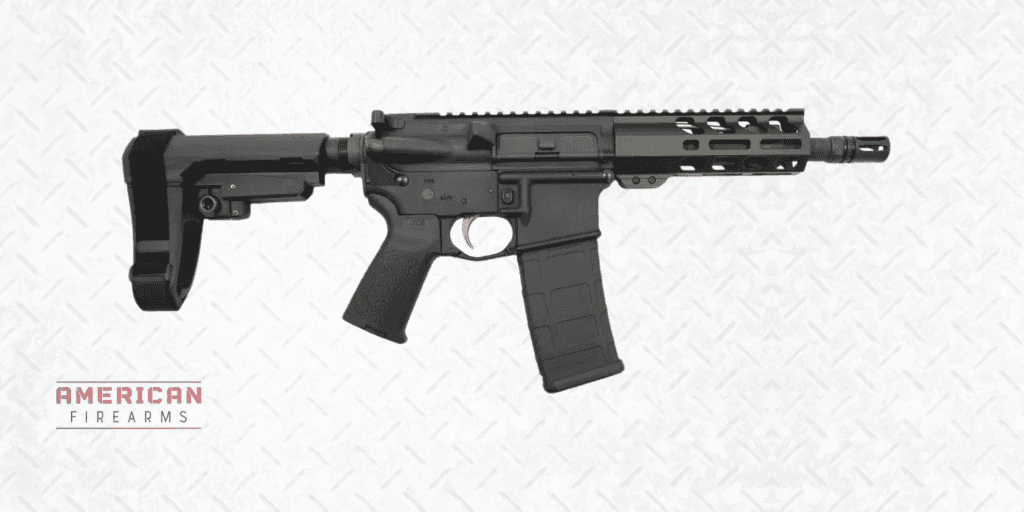
$599.99

21
AVERAGE
2025 Awards & Rankings
Performance Scores
Specifications:
- Barrel Length: 11.5”
- Capacity: 30
- Height: 7.75” at the pistol grip
- Caliber: 5.56mm
- Action: Direct Gas Impingement, Semi-Automatic
Pros:
- Awesome accessories and an overall package
- Reasonable price, especially for blemished or sale models
Cons:
- A2 birdcage flash hider insufficient for 5.56 out of an 11″ barrel
- Most models don’t come with iron sights
Palmetto State Armory is serious about their guns, sourcing the components for them from their vast network, which ensures you get an American-made firearm that is backed with a full lifetime warranty.
New shooters need reliability without breaking the bank. The PA-15 delivers proven performance at a price that leaves room for quality optics and training ammunition. The standard configuration teaches fundamentals without overwhelming beginners with unnecessary features.
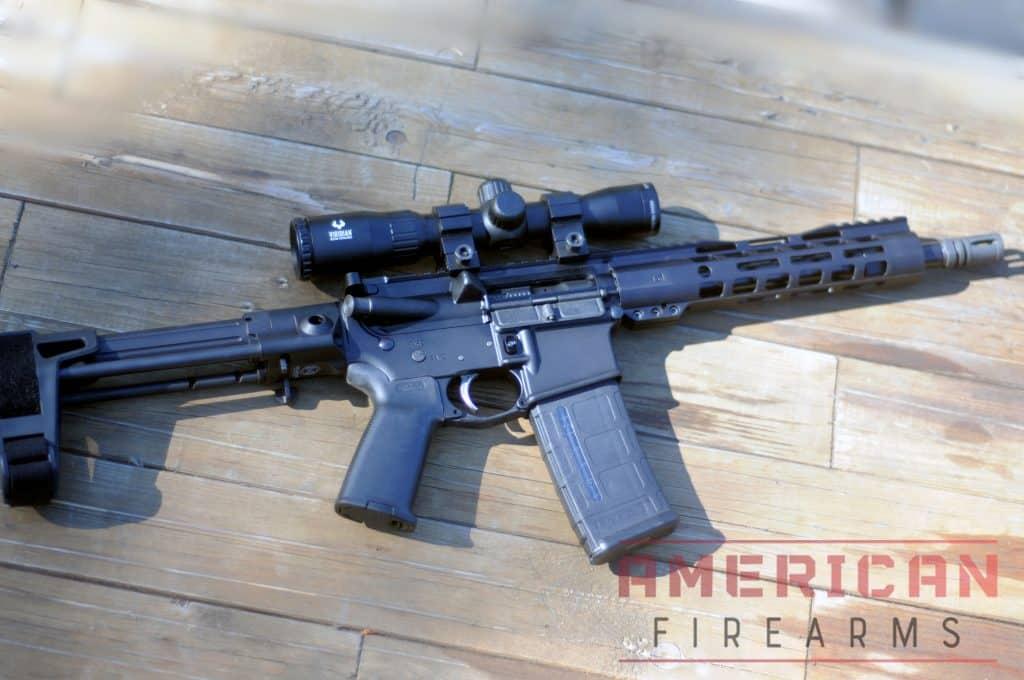
The PSA-15 pistol comes in a variety of configurations but the PSA-15 pistols pair 7075-T6 aluminum forged lowers and completed with a MOE EPT lower parts kit, SB Tactical SBA3 Adjustable Brace, and 7″ Lightweight M-Lok handguard. A lot of AR possibilities are packed into an affordable, mil-spec pistol package.
While Palmetto State Armory has historically been relegated to second-tier status in some circles, their recent releases — across 5.56x45mm NATO, pistol caliber, and large format options, have impressed.
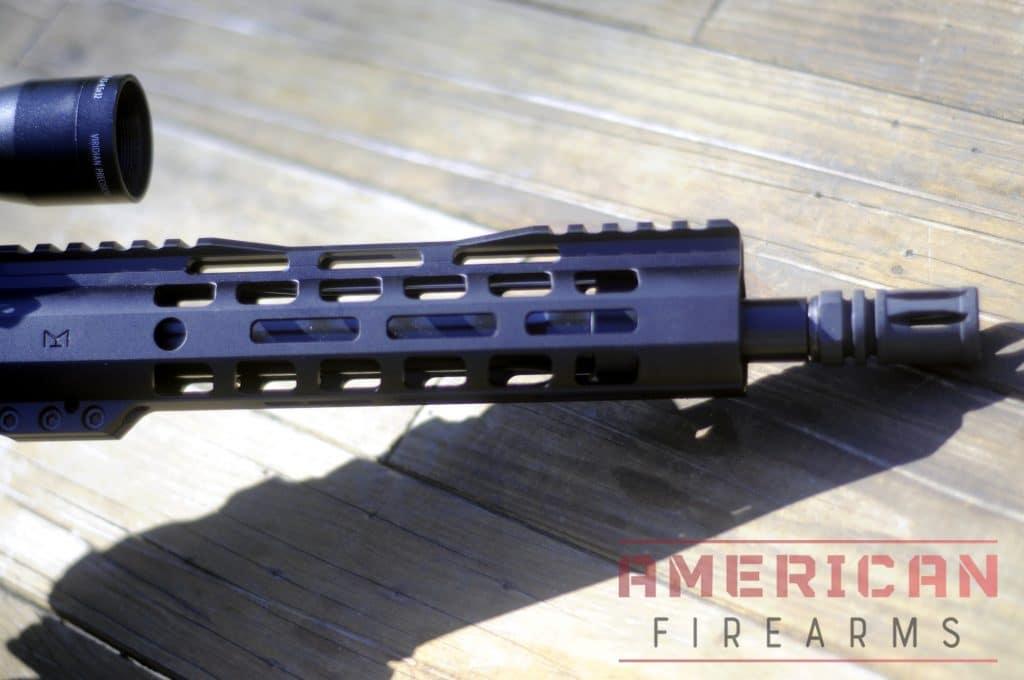
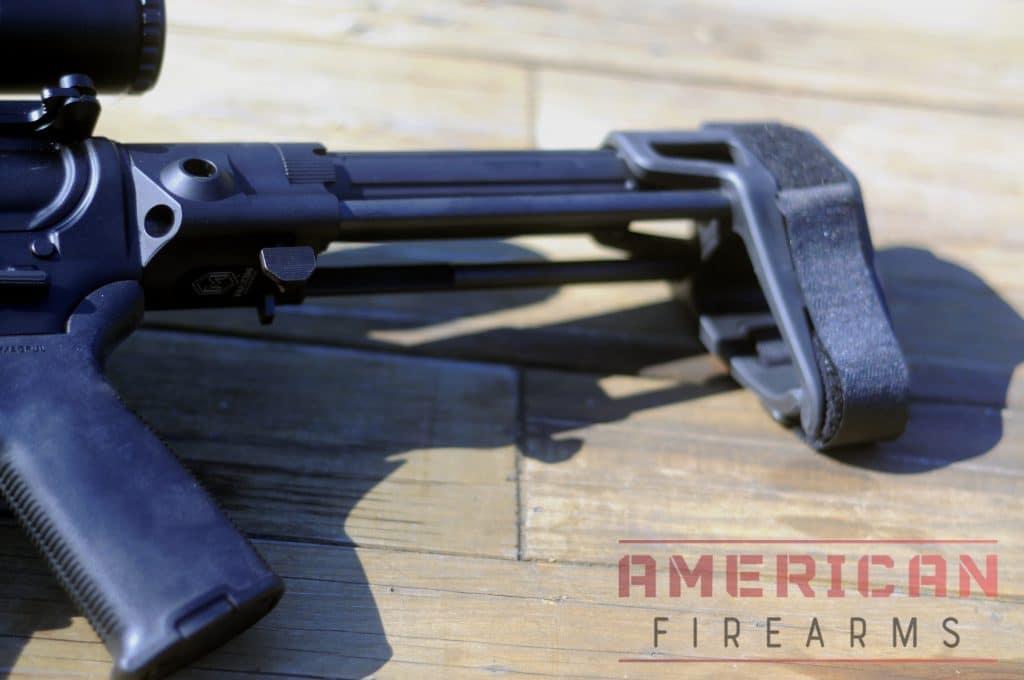
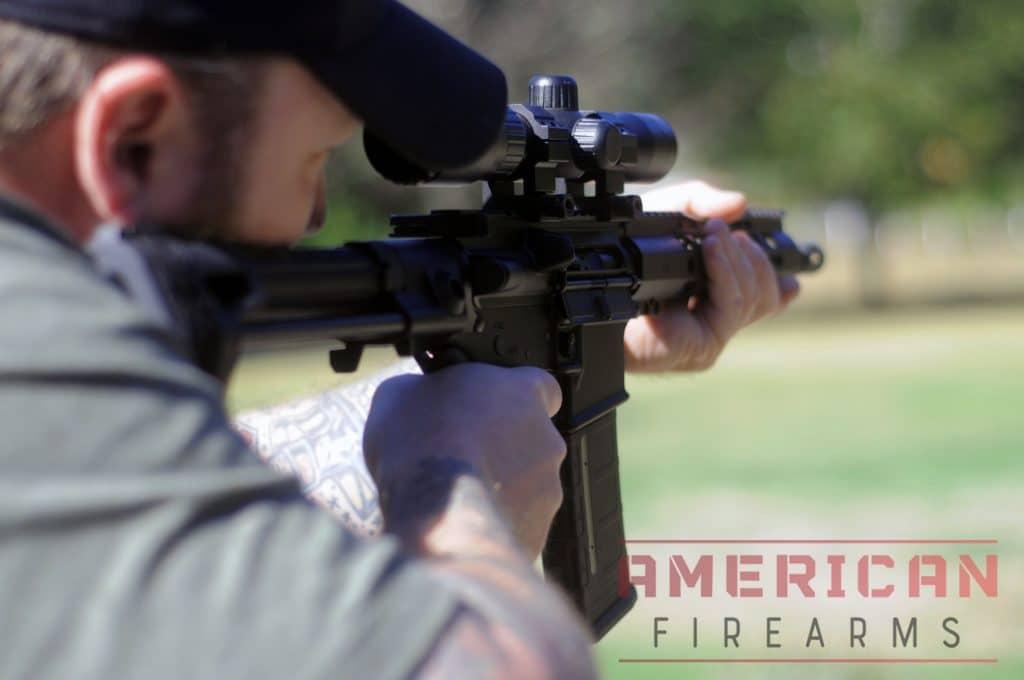
2. Professional/Duty Use Pick: Daniel Defense MK18
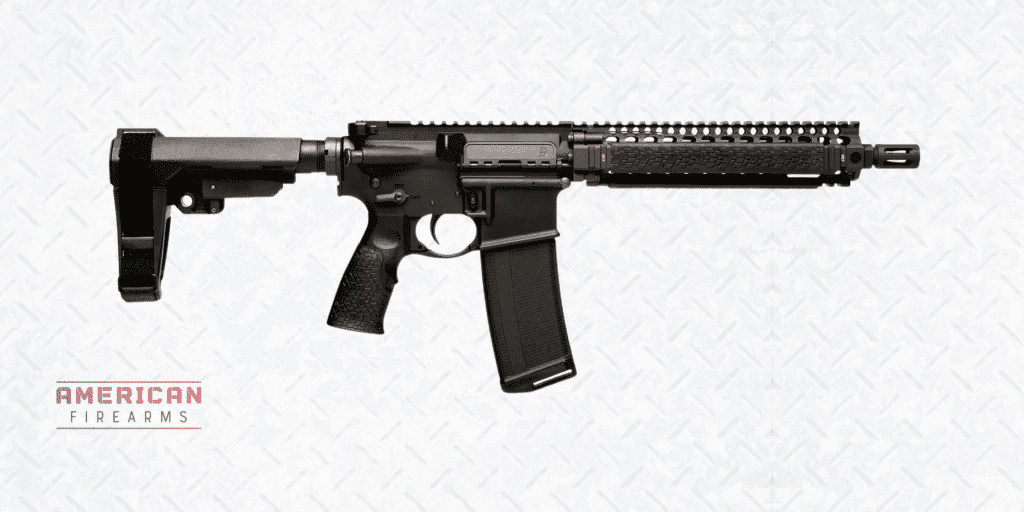
$2046

35
AVERAGE
2025 Awards & Rankings
Performance Scores
Specifications:
- Weight: 5.85lbs
- Length: 25.6”
- Barrel Length: 10.3”
- Capacity: 30
- Height: 7.75” at the pistol grip
- Caliber: 5.56mm
- Action: Direct Gas Impingement, Semi-Automatic
Pros:
- Fit & finish is top notch
- Bronze coloration on this pistol is truly stunning
- There’s lots of rail space
- Quality handguard
Cons:
- Non-standard pistol grip
- Iron sights would be nice
Georgia-based Daniel Defense scored huge gun culture points when their MK18 rifles were adopted for use by groups like the Navy SEALs.
When lives are on the line, the MK18’s military pedigree speaks volumes. The 10.3″ barrel balances performance with close-quarters capability. Premium components justify the cost for those requiring maximum reliability under stress.
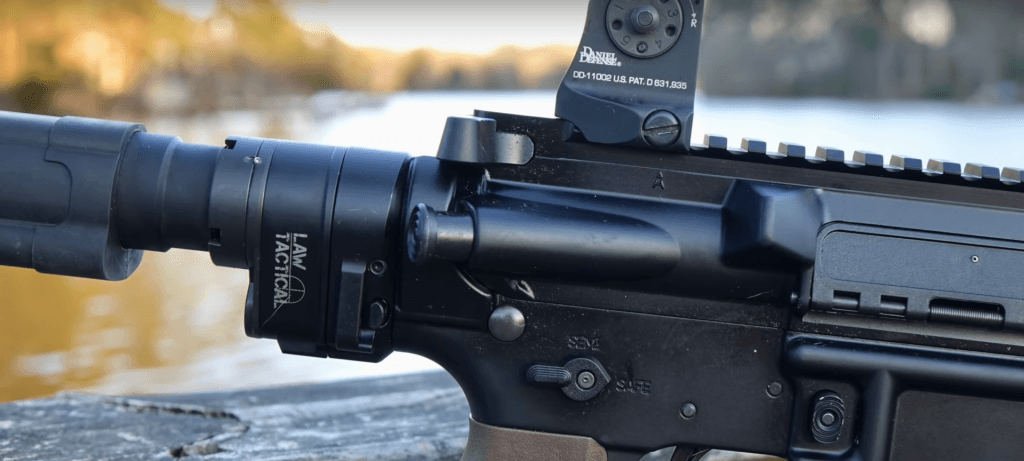
Looking to give the people the closest thing to it without talking to a recruiter, Daniel Defense introduced their DDMK18 pistol in 2015 complete with a RIS II rail system, 10.3-inch government profile barrel, and ambidextrous controls.
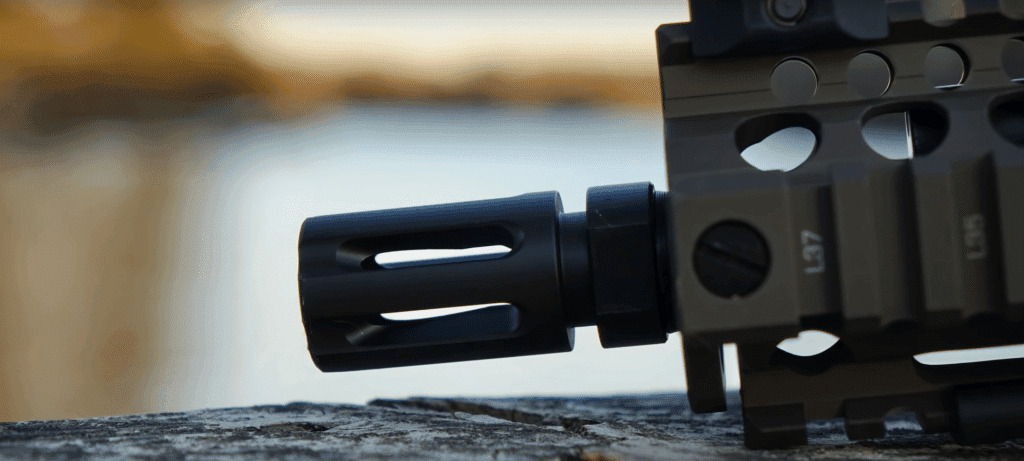
You almost have to wear a dive mask to shoot this one, and if you’re curious about Daniel Defense’s broader product line we reviewed the DDM4 rifle and the quality we experienced is indicative of what you’ll find with the MK18 — top notch.
3. Vehicle/Truck Gun Pick: Springfield Armory Saint Victor
Specifications:
- Weight: 5.5lbs
- Length :26.5”
- Barrel Length: 7.5”
- Capacity: 30
- Height: 7.5” at the pistol grip
- Caliber: 5.56mm
- Action: Direct Gas Impingement, Semi-Automatic
Pros:
- Effective muzzle device
- Handguard looks awesome
Cons:
- At 7.5”, do not expect long-range performance
- Changing the muzzle device requires removing the handguard
Springfield Armory has long been best known for the semi-auto M1A series M14-style .308 caliber rifles but has recently been branching out into the AR market with their SAINT line which includes a couple of pistols.
That 7.5″ barrel makes the Saint exceptionally compact for storage behind seats or in cases. The blast diverter helps manage the fireball inherent to short barrels. While you sacrifice some velocity, the portability advantage is undeniable for those needing maximum concealability.
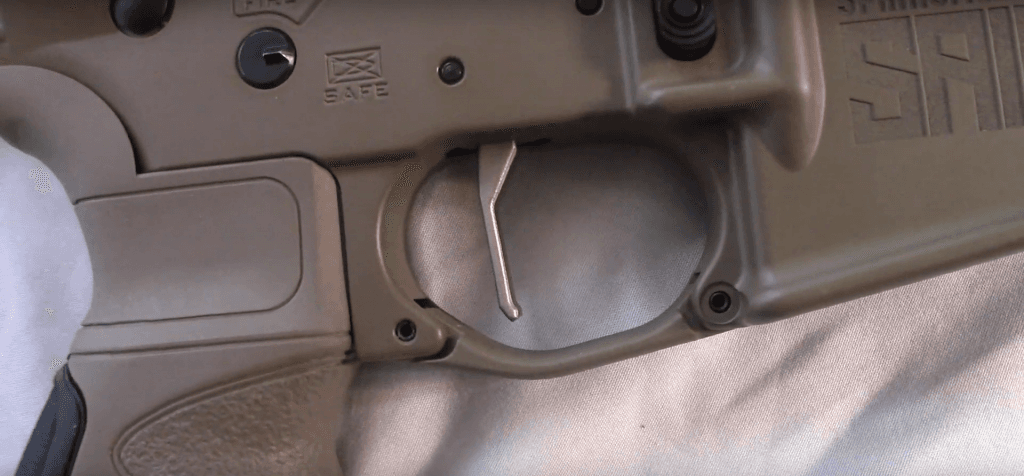
The Springfield Armory saint pistol line includes some interesting characters, such as the EVAC, which is a take-down gun a side-folding Tailhook brace.
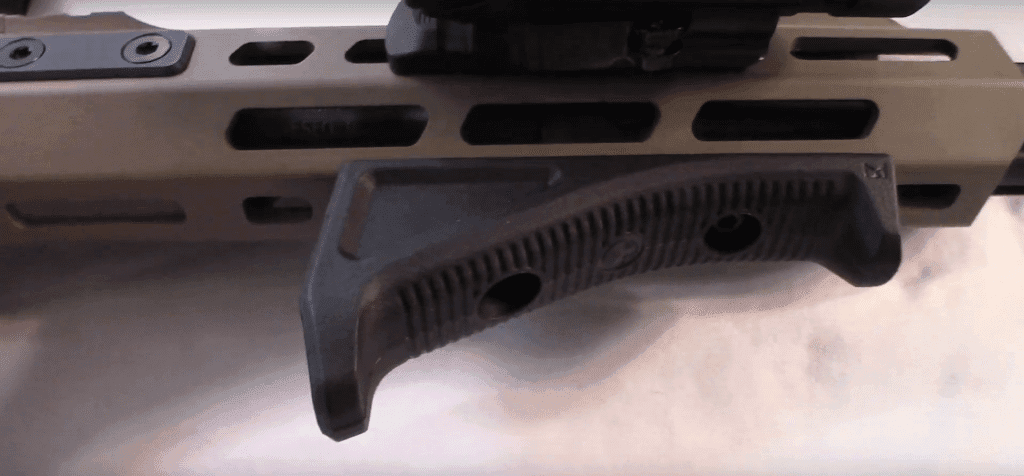
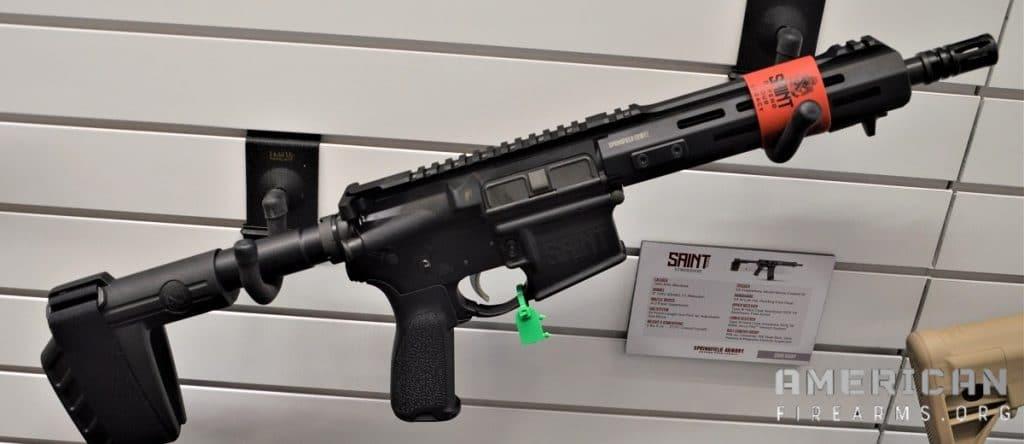
With its barrel and handguard removed and the brace folded, the largest portion of the Saint pistol is just 18 inches long. Only the old Olympic Arms OA-93, which does not use a buffer tube, is shorter and that is just by an inch.
4. Budget Option: Ruger AR-556 Pistol
Usability:
Quality:
Value:
Overall:
Specifications:
- Weight: 6.2lbs
- Length: 27.9”
- Barrel Length: 11”
- Capacity: 30
- Height: 7.2″ at the pistol grip
- Caliber: 5.56mm
- Action: Direct Gas Impingement, Semi-Automatic
Pros:
- Solid fit and finish
- Adjustable brace
Cons:
- Fully extended this is almost as long as an SBR
- Not much value overall
Running about the same price as a DB15 pistol but with an SB Tactical SBA3 brace is Ruger’s AR556 pistol.
Their reputation for accuracy shines in their AR pistol. The 10.5″ barrel and quality barrel treatment deliver surprising precision for the price point. Perfect for shooters wanting accuracy without premium pricing
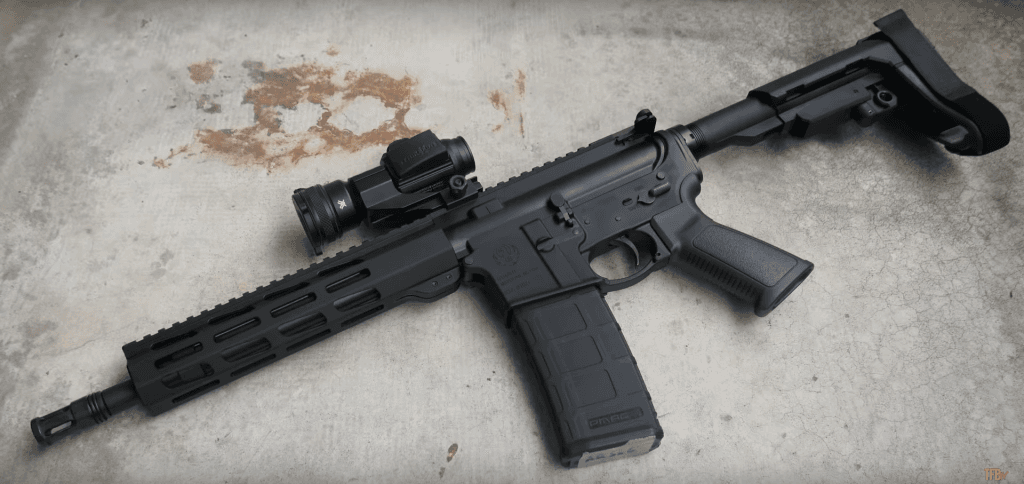
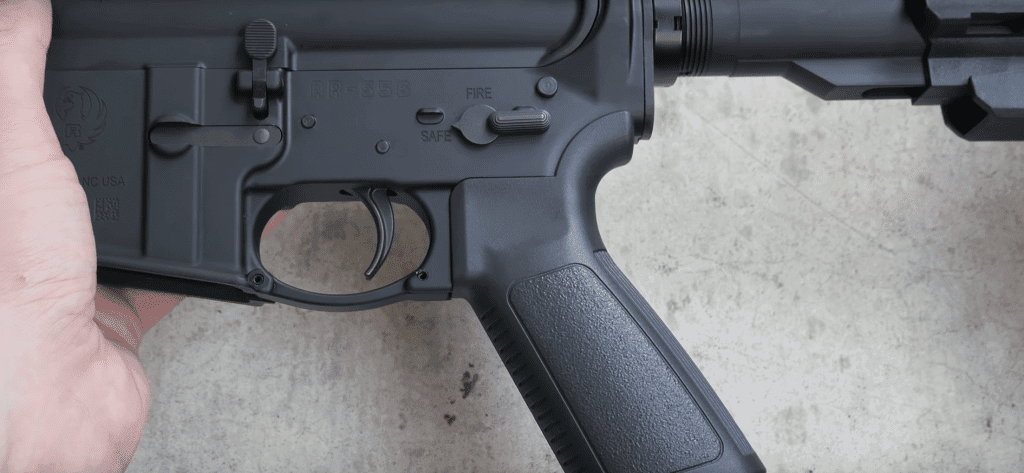
Featuring a 10.5-inch hammer-forged barrel and an M-LOK free-float aluminum handguard, the Ruger AR 556 pistol is an affordable AR-pattern handgun that checks a lot of boxes if you want an AR for under $1K that has both name recognition and a 10.5 inch barrel.
5. Home Defense Pick: BCM RECCE 11
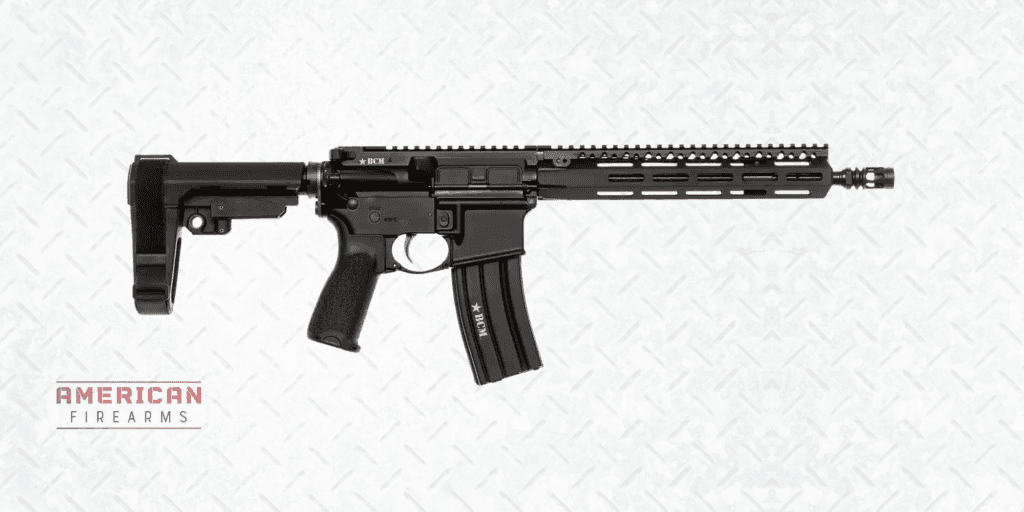
$1734.99

31
AVERAGE
2025 Awards & Rankings
Performance Scores
Specifications:
- Weight: 5.5lbs
- Length: 27”
- Barrel Length: 11.5″
- Capacity: 30
- Height: 7.5” at the pistol grip
- Caliber: 5.56mm
- Action: Direct Gas Impingement, Semi-Automatic
Pros:
- Proven reliability
- BCM controls and accessories makes this a great overall package
Cons:
- Front heavy
- Light-profile barrel might not do so well under sustained fire
Announced in 2016, the compact RECCE (rek-eey) series AR-15 pistols by Bravo Company use an enhanced profile barrel with a reliable carbine-length gas system and M4 feed ramps as well as (go figure) lots of BCM accessories for not a lot of cash.
The 11.5″ barrel delivers serious terminal performance while remaining maneuverable in tight spaces. Carbine-length gas system ensures reliable cycling with defensive ammunition. The proven BCM reliability means it’ll work when your life depends on it. Add a weapon light and red dot for the complete home defense package.
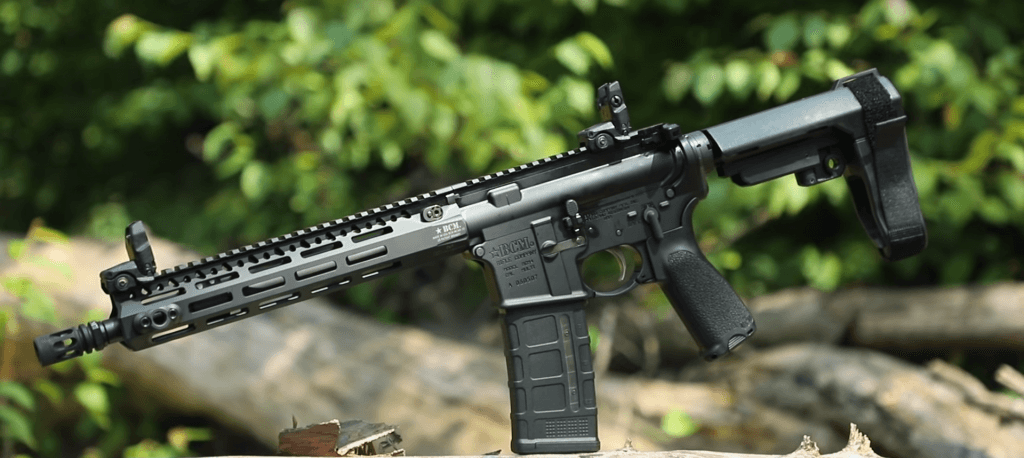
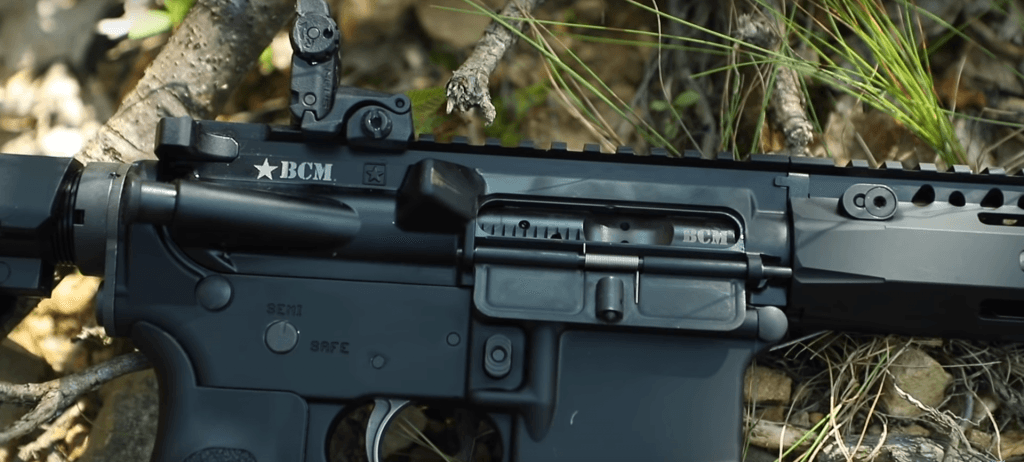
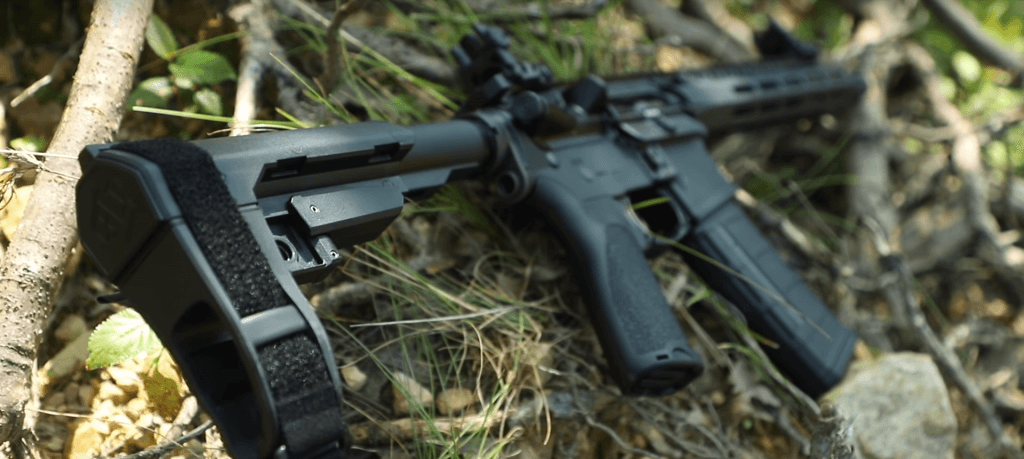
6. Range/Competition Pick: Sig Sauer M400 Tread
Specifications:
- Weight: 6lbs
- Length: 27”
- Barrel Length: 11.5”
- Capacity: 30
- Height: 7.5” at the pistol grip
- Caliber: 5.56mm
- Action: Direct Gas Impingement, Semi-Automatic
Pros:
- Angular features
- Distinctly contemporary look
- Upgraded trigger is smooth and breaks cleanly
Cons:
- Brace is thin enough to be fairly uncomfortable to shoot
- Skeletonized handguards can get hot
No old-school SB15 brace here
Sig can be credited with making the AR pistol mainstream today their top-shelf model is the MPX Canebrake piston gun while the people’s champ is the more practical M400 Tread which comes standard with the more modern Shockwave Blade multi-position brace rather than the now old-school SB15.
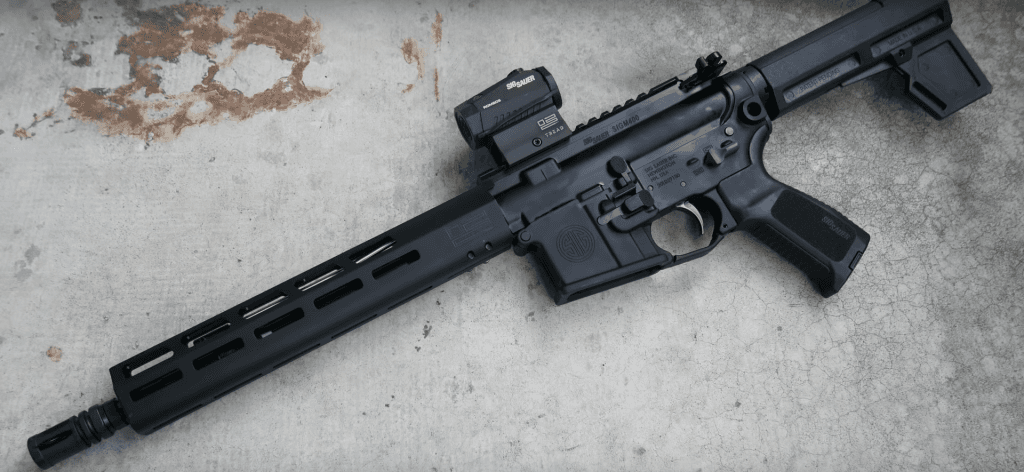
The flat trigger and 11.5″ barrel offer excellent accuracy potential for PCC matches or range sessions. Modern furniture and ergonomics make extended shooting more comfortable. The Shockwave brace provides solid stability for precision work.
Using an 11.5-inch nitride-coated barrel, it is one of the longest such pistols on the market but brings with it a lot of solid performance. Really tough to go wrong with this one.
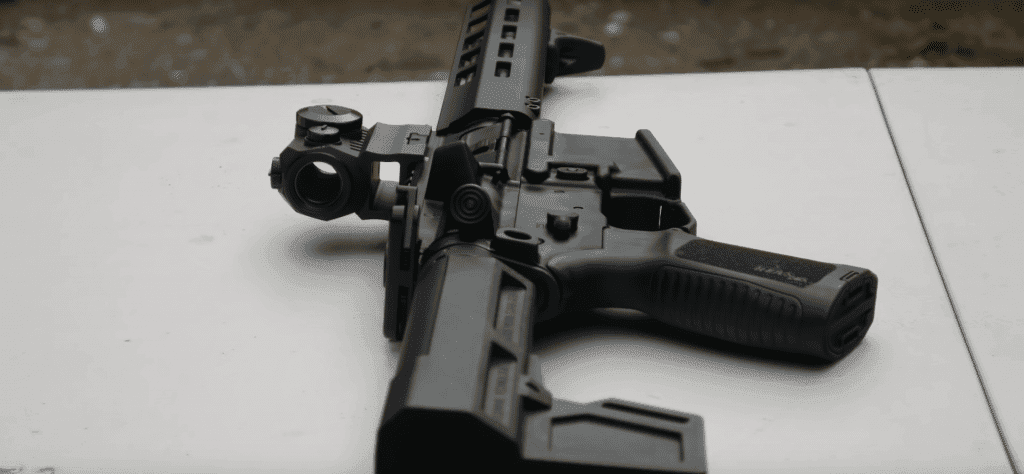
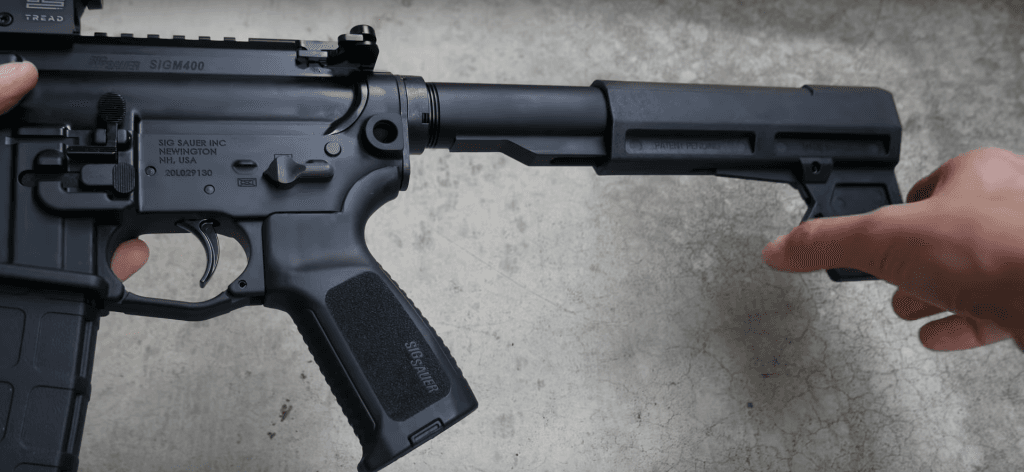
7. .300 Blackout Specialist: Barrett REC7 DI AR Pistol
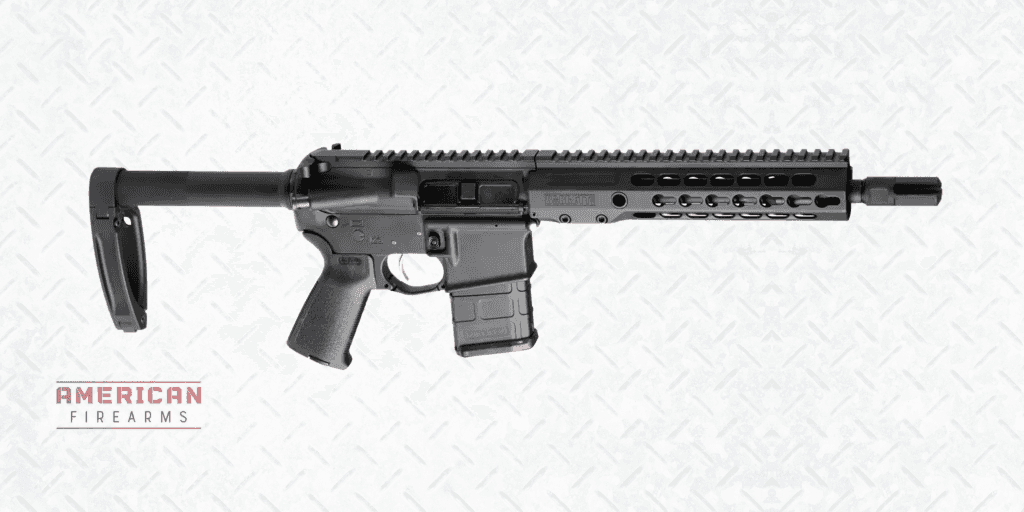
$2040.99

37
AVERAGE
2025 Awards & Rankings
Performance Scores
Specifications:
- Weight: 5.5lbs
- Length: 26.2”
- Barrel Length: 10.25”
- Capacity: 30
- Height: 7.5” at the pistol grip
- Caliber: .300 Blackout
- Action: Direct Gas Impingement, Semi-Automatic
Pros:
- Industry-leading barrel and muzzle brake
- Rail is exceptionally solid
Cons:
- Brace cannot be adjusted
- Non-ambi controls
Tennessee-based Barrett won their laurels with .50 BMG precision rifles and followed it up with a line of very nice REC7 series ARs.
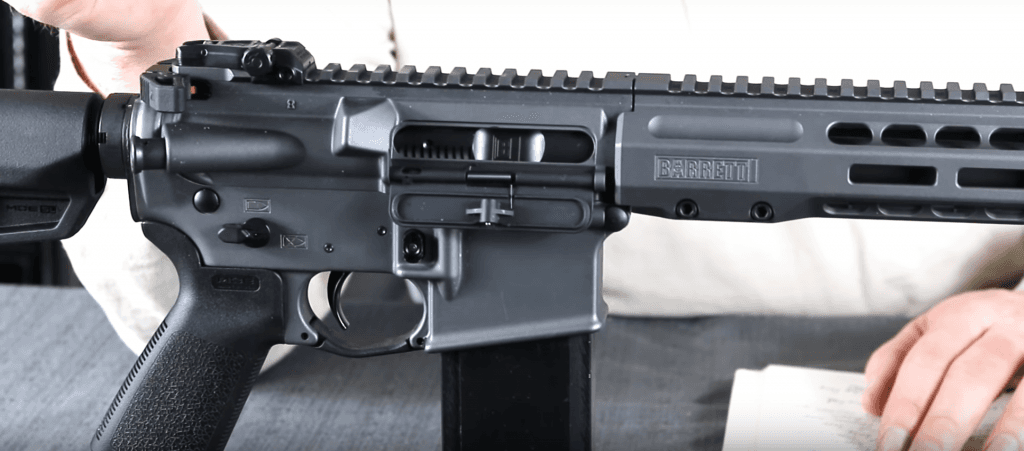
In 2017, the company introduced a direct impingement pistol variant that includes a milled billet receiver, advanced trigger, and nickel-boron BCG, proving the adage of “you get what you pay for.”
When you need subsonic capability or maximum effectiveness from short barrels, the Barrett in .300 Blackout excels. The milled receiver and premium components justify the cost for suppressor enthusiasts or those requiring optimal short-barrel ballistics. If you’re interested in .300 Blackout in general we pulled together our list of the best .300 Blackout firearms available today.
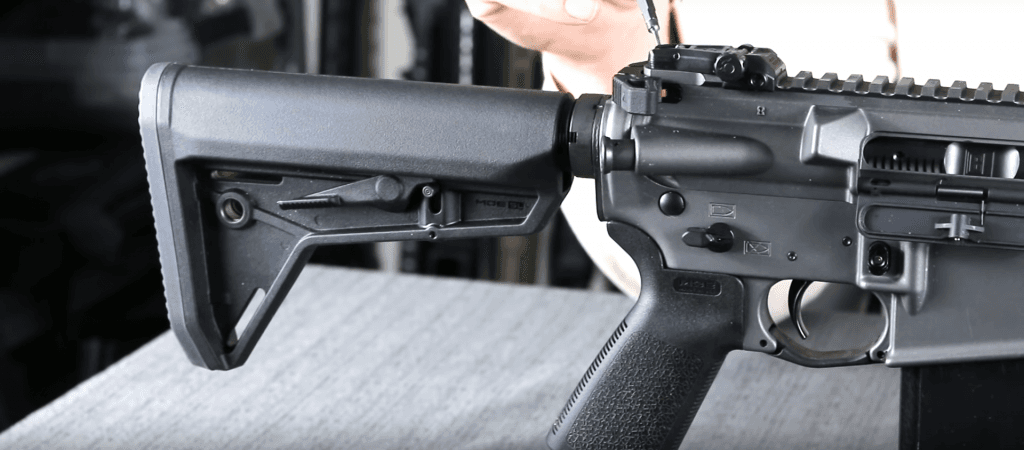
If I was in the market for the Daniel Defense pistol and didn’t want to wait around, I’d grab a Barrett in a heartbeat.
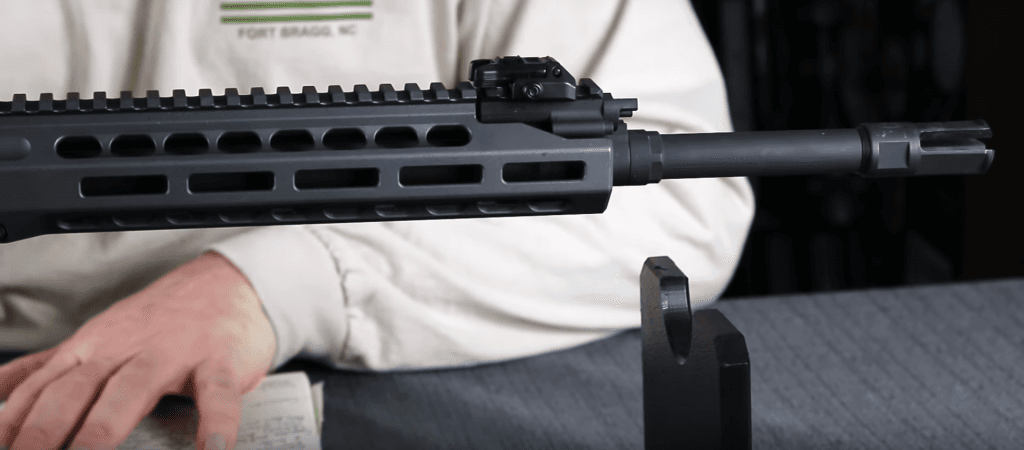
8. Ultra-Compact Budget: Diamondback DB15 AR Pistol
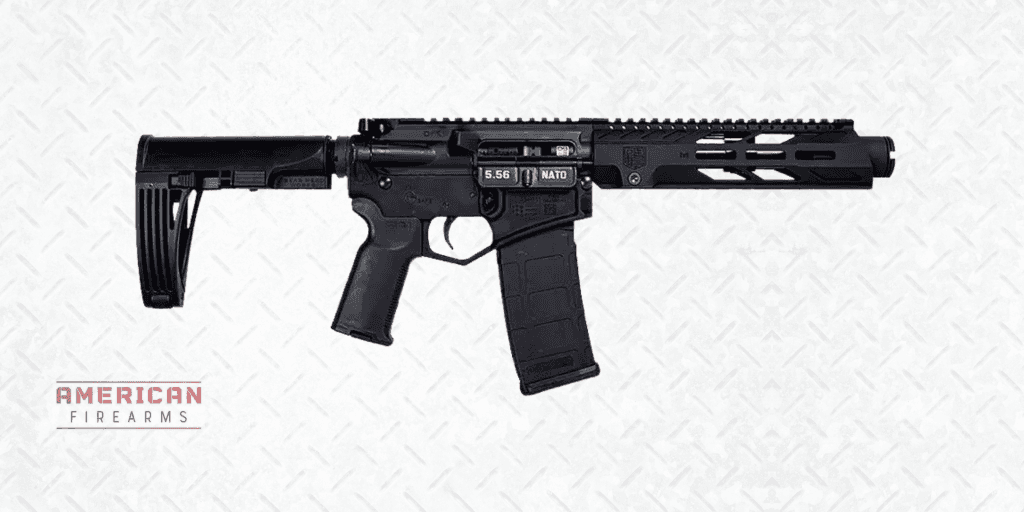
$932

33
AVERAGE
2025 Awards & Rankings
Performance Scores
Specifications:
- Length: 23”
- Barrel Length: 7.5”
- Capacity: 30
- Height: 7.5” at the pistol grip
- Caliber: 5.56mm
- Action: Direct Gas Impingement, Semi-Automatic
Pros:
- Exceptionally lightweight
- Packed with nice features
Cons:
- No brace at all on this model
- Bulky muzzle device
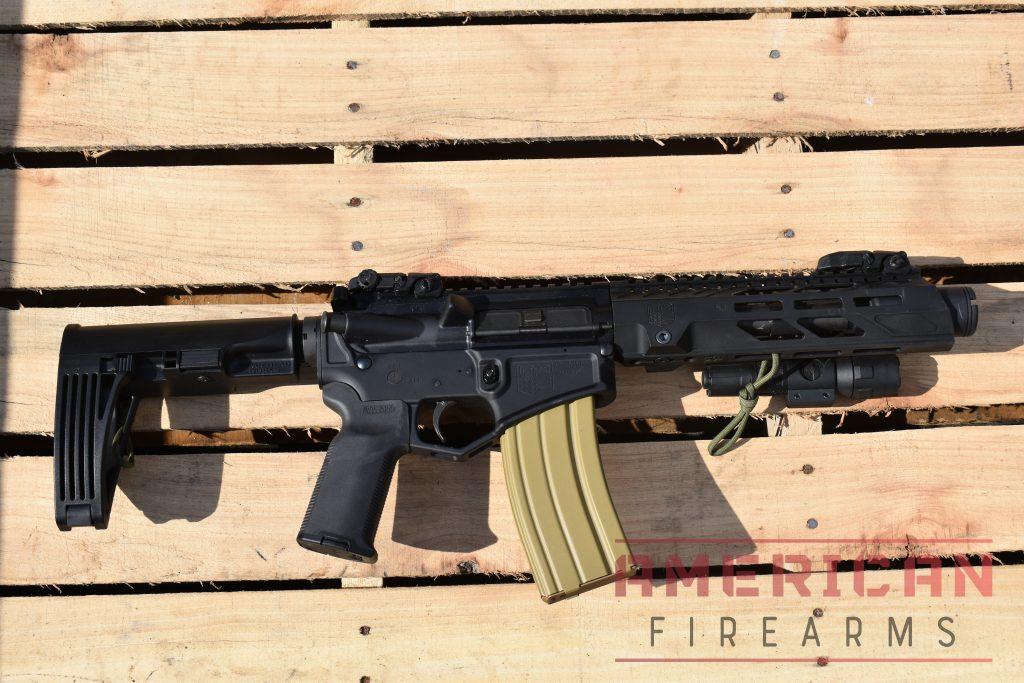
Diamondback jumped into the AR pistol game back in 2013 when it was still a small pond and has since matured into an increasingly larger fish as the pond expanded into a downright lake.
At 7.5″ and under 5.5 pounds, the DB15 maximizes portability while minimizing cost. Ideal for those prioritizing absolute compactness over velocity, or as a lightweight backup option. The aggressive pricing makes it accessible for budget-conscious buyers.
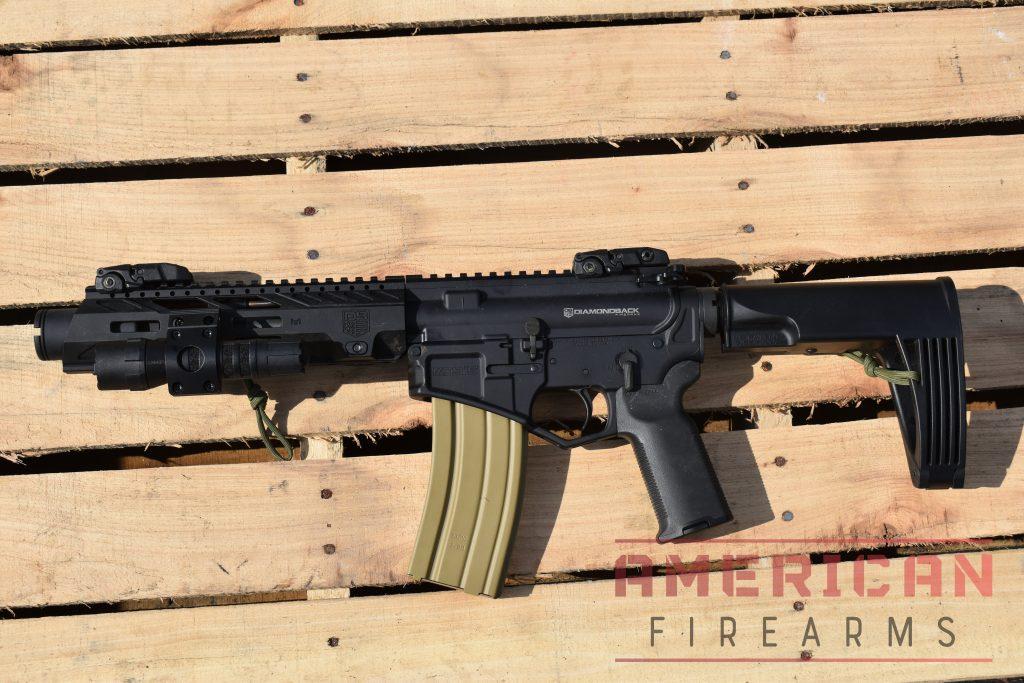
Today, their DB15 line includes pistols in 7.5- and 10-inch formats and with Gearhead Tailhook braces. Further, other than building your own gun or going with an option that uses a polymer lower, it is hard to find an AR-15 pistol anywhere for a better price point.
If you’re interested in Diamondback firearms we broke down their current product lineup in our DB review.
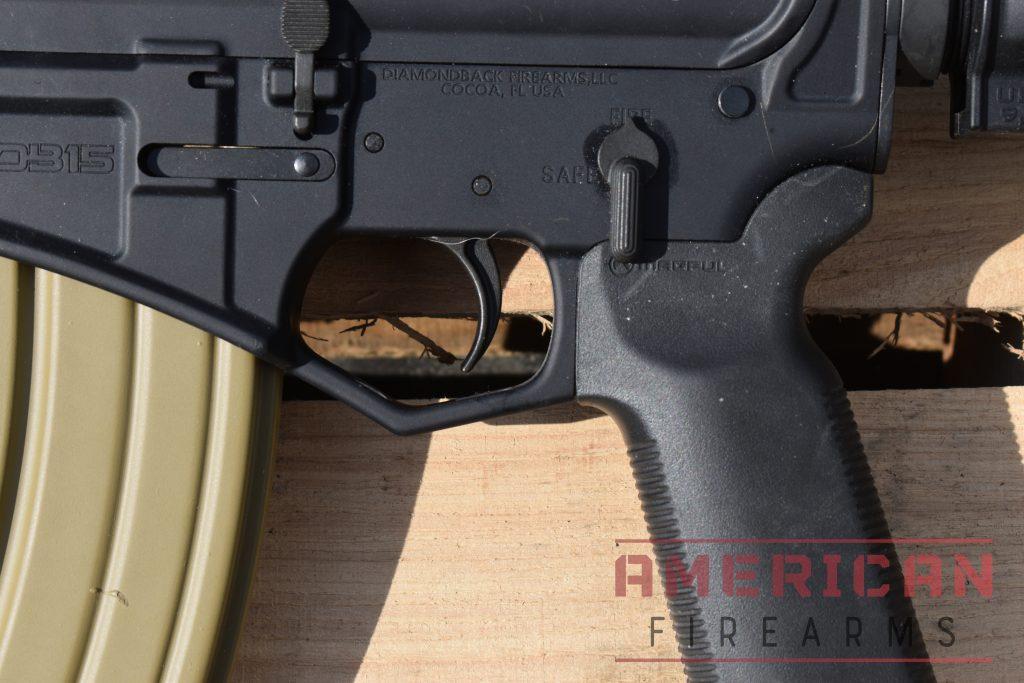
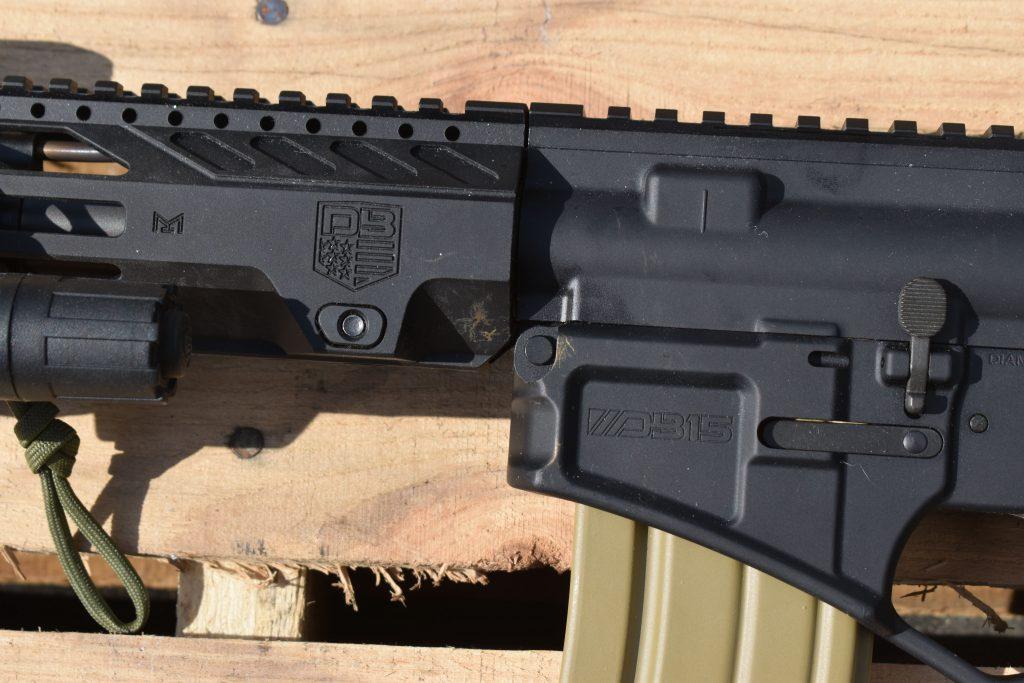
9. Military Heritage/Collector Pick: FN 5.56 Pistol
Usability:
Quality:
Value:
Overall:
Specifications:
- Weight: 6.2lbs
- Length: 26.25”
- Barrel Length: 10.5”
- Capacity: 30
- Height: 7.5” at the pistol grip
- Caliber: 5.56mm
- Action: Direct Gas Impingement, Semi-Automatic
Pros:
- Proven & reliable
- Upgraded trigger
Cons:
- Standard A2 birdcage
- Some models do not come with a brace
For those wanting authentic military contractor quality, FN delivers the same expertise that supplies the U.S. military. The chrome-lined barrel ensures longevity, while the upgraded trigger improves the shooting experience. Perfect for collectors or those prioritizing proven military specifications.
While Colt popularized the AR-15, it was FN that ran with the design and has been a key government supplier of first the M16A4 and then the M4 for decades.
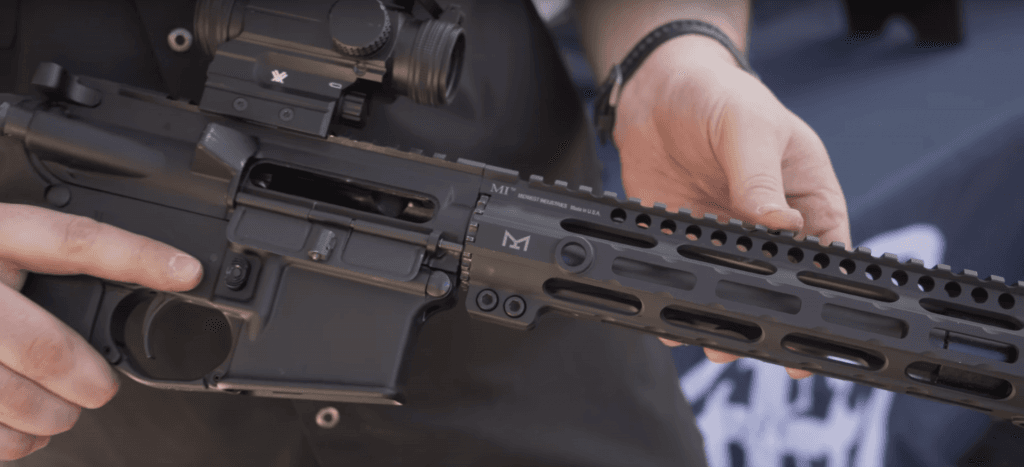
Also, while Colt hasn’t dipped their toe into the AR pistol pool, FN has embraced it and has been marketing a 10.5-inch chrome-lined model with an SBX-K brace for the past few years.
If the military was looking to buy crates of semi-auto AR pistols, they would probably call FN direct.
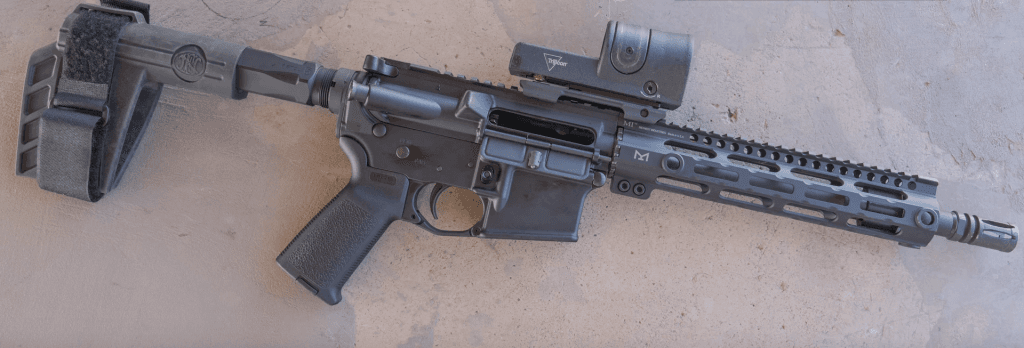
Use Case Scenarios & Recommendations
Home Defense Applications
If you’ve never had to clear a house with a rifle, you probably don’t know how tough it is to swing a long, heavy-barreled rifle in and out of doors, up staircases, and around rooms. Pistols deliver serious terminal performance while remaining maneuverable in hallways and around corners — all with a platform that supports all the lights, optics, and accessories you could want.
For defensive use, prioritize reliability and maneuverability over long-range performance. Barrel lengths between 10.5-11.5 inches offer optimal balance – enough velocity for terminal effectiveness while remaining compact for hallways and tight spaces.
Carbine-length gas systems provide more reliable cycling with defensive ammunition than shorter pistol-length systems. Essential accessories include weapon lights and close-range optics like red dots or holographic sights.
Professional/Duty Use
AR pistols are a necessity when it comes to law enforcement and military applications, where premium components justify the cost for demanding professional applications.
When reliability is non-negotiable, focus on proven platforms with extensive testing records. Military and law enforcement applications typically favor 10.3-11.5″ barrels for close-quarters effectiveness. Premium components like chrome-lined barrels and enhanced bolt carrier groups justify higher costs when lives depend on performance.
Vehicle/Truck Gun Setup
As for civilians, AR pistols make great truck and home defense guns. If you don’t want to have to dig out a rifle from under your seat or pepper your drywall with buckshot when an intruder breaks in. An AR pistol should be your weapon of choice (although not intended for shoulder firing, few use the brace as intended.)
Storage space drives barrel length decisions when it comes to truck guns. Ultra-short 7.5-8″ barrels maximize compactness for behind-seat storage or case portability.
Expect significant muzzle flash and reduced velocity, but the space savings often justify these trade-offs. Consider muzzle devices that manage blast direction and look for robust construction that handles vehicle vibration and temperature extremes.
Competition & Training
PCC matches and extended range sessions benefit from longer barrels (11.5-12.5″) that improve accuracy and reduce gas blowback. Upgraded triggers enhance precision, while quality braces provide stable shooting platforms. Weight becomes important during long competitions – consider lightweight handguards and efficient accessory mounting.
What to Look for in a Quality AR Pistol
1. Barrel Length Considerations
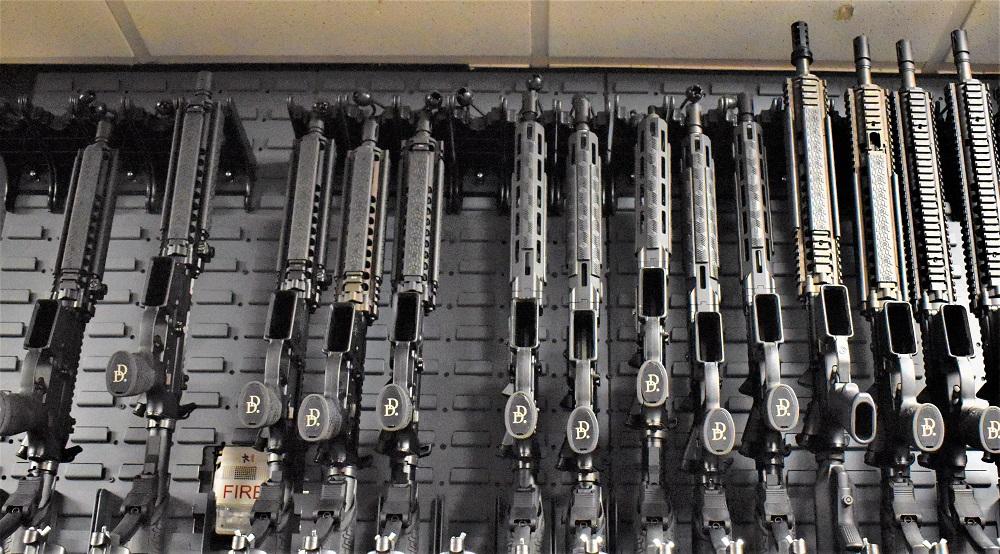
While in theory AR pistols can have a barrel of almost any length over 4-inches– which is the minimum gas port dwell required to work Stoner’s direct gas impingement action– about the shortest marketed have been 5.5-inches.
The ATF defines a pistol as “A weapon originally designed, made, and intended to fire a projectile (bullet) from one or more barrels when held in one hand, and having (a) a chamber(s) as an integral part(s) of, or permanently aligned with, the bore(s); and (b) a short stock designed to be gripped by one hand and at an angle to and extending below the line of the bore(s).”
In short, a one-handed, short-stocked firearm.
There have been downright near-rifle-length pistol models on the opposite end of the spectrum. Subtracting these extremes produces a happy median of between 7.5- and 11-inches for the typical AR build — a zone that has proved the most appealing for these handguns, especially as this span allows for a more reliable carbine-length gas port system with a low-profile gas block rather than the shorter and dirtier pistol-length system.
Velocities & Performance Impact
Studies by experts in the firearms field have shown that, while the 5.56mm NATO in most loads will break over 3,000 fps velocity when fired from any barrel length over 14.5-inches, this speed starts to dump rapidly to the point that short barrels just 10-inches long will lose about a fifth of that, running about 2,400 fps.
In other words, more barrel = more velocity, and the opposite is also true.
By the time you chop a barrel down to the 7.5-inch mark, which is about the minimum length that is still practical, you are good to wring 2,000 fps out of standard AR ammo with lower velocity leading to a less gyroscopically stable bullet and lower energy in the bullet when it reaches the target.
Another side effect of shorter barrels is that the stubbier they get, the more powder remains unburnt, which gives the gun a higher uncorking pressure at the muzzle, translating to a bigger and more distracting muzzle blast or fireball.
In short (excuse the pun), the longer the barrel on an AR-15 pistol, the more accurate, useful, and easier to shoot it will be.
On the other side of the coin, the shorter the barrel, the more the ammunition’s performance envelope will decline, and the user will observe a more pronounced muzzle flash, the latter of which can be smoothed out with muzzle devices such as flash cans or through the use of suppressors, provided a can fits with your intended use.
In the end, the AR-15 pistol offers a lot for the discerning firearms collector and fills a niche that generations of gun buyers have been looking to satisfy. These days, the question is not, “why do I need one?” but more so, “why don’t I have one?”
Want more on barrels? Read our barrel explainer.
Barrel Specifications Comparison
Understanding barrel specs is crucial for AR pistol performance. Here’s how our top picks stack up:
| Model | Length | Profile | Twist Rate | Material | Treatment | Dwell Time | Velocity (55gr) |
|---|---|---|---|---|---|---|---|
PSA PA-15 | 11.5" | Government | 1:7 | 4150 CMV | Nitride | Good | ~2400 fps |
Daniel Defense MK18 | 10.3" | Government | 1:7 | CHF 41V50 | Chrome Lined | Adequate | ~2300 fps |
Springfield Saint | 7.5" | Government | 1:7 | 416R SS | Melonite | Short | ~2000 fps |
Ruger AR-556 | 10.5" | Government | 1:8 | 4140 | QPQ | Adequate | ~2350 fps |
BCM RECCE 11 | 11.5" | Enhanced | 1:7 | 4150 CMV | Chrome Lined | Good | ~2400 fps |
Sig M400 Tread | 11.5" | Government | 1:7 | 416R SS | Nitride | Good | ~2400 fps |
Barrett REC7 | 10.25" | Government | 1:7 | 416R SS | Nitride | Adequate | ~2320 fps |
Diamondback DB15 | 7.5" | Government | 1:7 | 4150 CMV | Nitride | Short | ~2000 fps |
FN 5.56 | 10.5" | Government | 1:7 | 4150 CMV | Chrome Lined | Adequate | ~2350 fps |
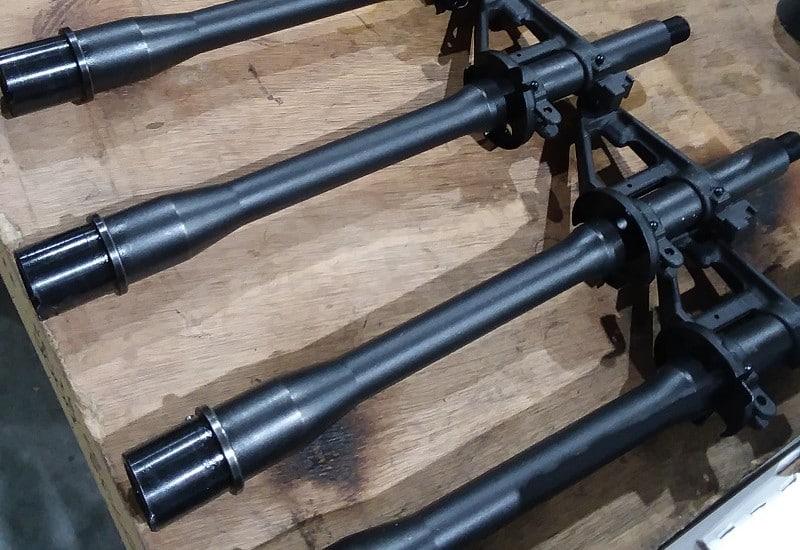
Barrel-Specific Insights:
- 11.5″ barrels offer the best balance of velocity and portability
- Chrome-lined barrels provide superior longevity for high-volume shooting
- 1:7 twist handles heavier bullets better than 1:8, important for defensive loads
- Dwell time affects reliability – longer is generally better for consistent cycling
2. Barrel Profiles & Materials
Barrels are designed with different profiles, or essentially, metal thickness. A thick profile means the barrel has the same profile (thickness) from end to end.
These barrels are heavier but are also more accurate and take longer to wear down. A thin profile, or pencil profile, is lightweight but may wear out sooner. These can also be referred to as contours. The shape of the barrel may change contours but still perform its duty.
3. Barrel Linings
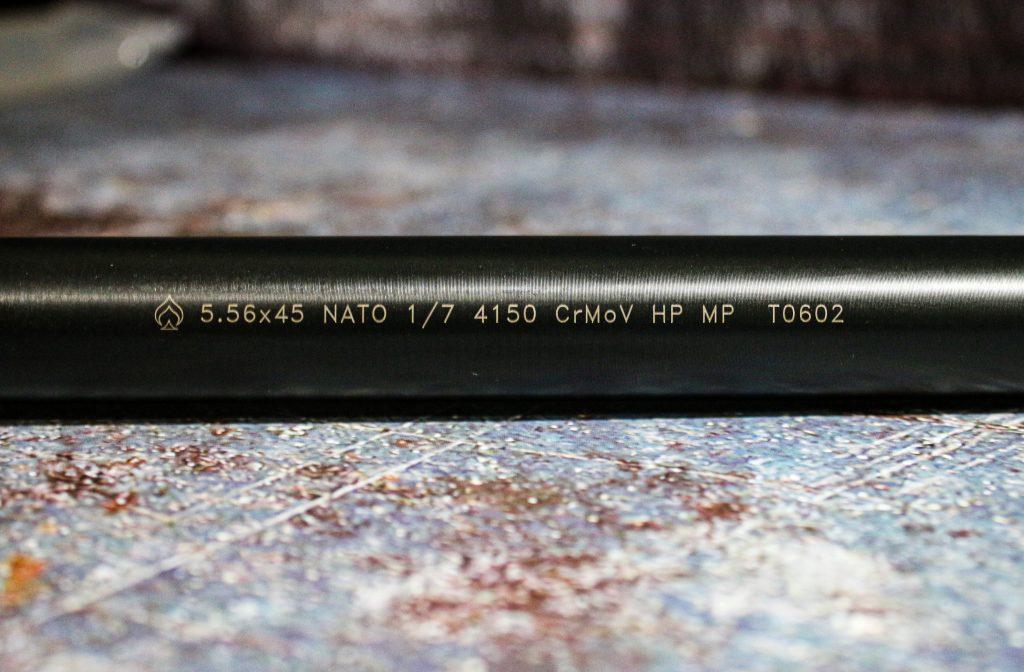
Wearing out a barrel refers to wearing down the linings. This is the rifling of the barrel. The lining takes a real beating when a barrel heats up from extended firing.
Interestingly, just because a thick profile has more material to be more durable, it’s also harder to cool down. Thin profiles heat up faster, but they cool more quickly.
Barrels can be manufactured in three ways: cutting, button rifling, and forging. Cut rifling is when a machine cuts each rifle groove one time. Button rifling is where a plug is forced from one end of the steel blank barrel to the other end.
As it passes through the steel, it creates grooves.
Forging uses a tungsten “negative,” inserted into a steel “blank” as a large machine hammers the steel around the tungsten. This creates a rifling pattern.
4. Bolt Carrier Groups (BCG)
One of the advantages of building or buying an AR pistol is that the BCGs are the same as any standard AR-15 BCG.
The BCG contacts the cartridge & the byproducts of the firing sequence, which means It needs to be cleaned often.
Each component that makes up a BCG is important. The parts include a bolt, ejector, ejector spring, ejector roll pin, extractor, extractor pin, extractor spring, three gas rings, bolt carrier, bolt cam pin, carrier key, two bolt carrier key screws, firing pin, and firing pin retainer pin.
When the trigger is pulled, the firing pin ignites the primer, and the round takes off. The gas is funneled back into the gas key and down into the BCG. The three gas rings create a chamber by blocking off access to the rest of the group.
This forces the bolt carrier back against the recoil spring as the cam pin twists the bolt to let the BCG move rearward. Then it all resets as the cartridge extracts and chambers the next round.
Gas Systems Explained: DI vs. Piston Sytems
An AR pistol can be built with direct impingement (DI) or new gas piston technology.
If you’ve never heard of direct impingement, and you own an AR-15, your rifle was most likely built with this system. DI has been tested and proven reliable for years as its the original technology devised by Eugene Stoner.
Take a look at your barrel. There should be a small hole located in the barrel that lines up with the gas tube to direct gas to impinge on the carrier mechanism.
This is what causes gas blowback, but it is how your entire rifle functions. This gas pressure allows the empty cartridge to eject and the next one to seat in the chamber. (This is also why your rifle builds up with carbon).
The gas piston technology is only similar in that the gas is diverted through the barrel, but instead of a gas tube, it’s contained within a cylinder with a piston.
The gas moves this piston which performs the ejection process of the spent brass. The bolt carrier is pushed forward by a spring to close. If you own an AK-47, you most likely have a piston system.
You’re probably thinking, what’s better? Well, that depends on what you want to accomplish with the gun. The DI system is more common, which means parts are easy to find and relatively inexpensive. However, the bolt carrier will heat up and needs to cool down before it can be removed from the rifle. Regular cleanings are also recommended.
The piston gas system keeps the rifle’s action cool, meaning the bolt carrier can be removed and held in your hand immediately after firing. This system does increase recoil and can decrease accuracy, especially with multiple shots fired in succession.
Lastly, parts are not interchangeable between piston guns, so if you use this system, it’s wise to buy replacement parts simultaneously for that specific gun. Read on with our gas system explainer.
5. Optics & Sighting Systems
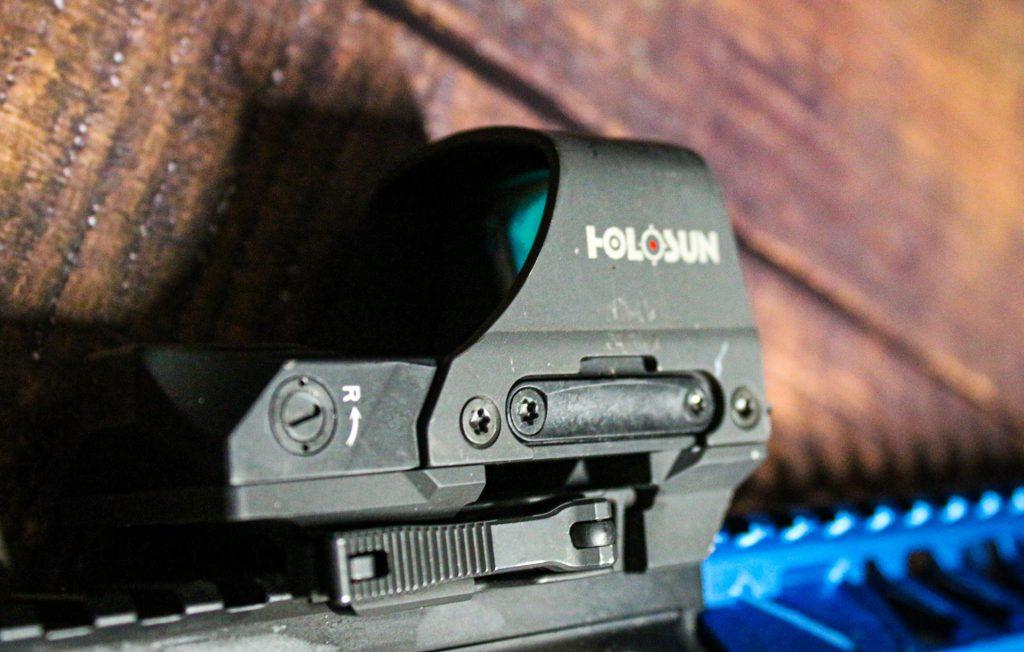
Optics are an important consideration. An AR pistol should have an optic that is easy to pick up and use quickly (the last thing you want to mount on this gun is a scope.)
I’m a little old-fashioned, so a pair of iron sights, preferably a folding set, is a must for us on every AR we own. While you won’t get much in the way of ranged accuracy thanks to the short sight radius on AR pistols, the option to use them is always better than not.
From there, we also highly recommend a micro red dot sight on your AR pistol: magnified optics tend to be a little too bulky for our tastes here, as the point of an AR pistol is to keep things small and compact whenever possible.
Red dots will be the most advantageous optic to use in close-quarters combat. While not an optic, another consideration is a laser or a laser/light combination. Lasers have to be sighted in just like any other optic but can allow a person to set the laser on an attacker without ever having to look through an optic.
While many defensive situations happen in daylight, many more occur at night. Without an optic, laser, flashlight, or something you can see, aiming will be more difficult in low light.
6. Furniture & Accessories
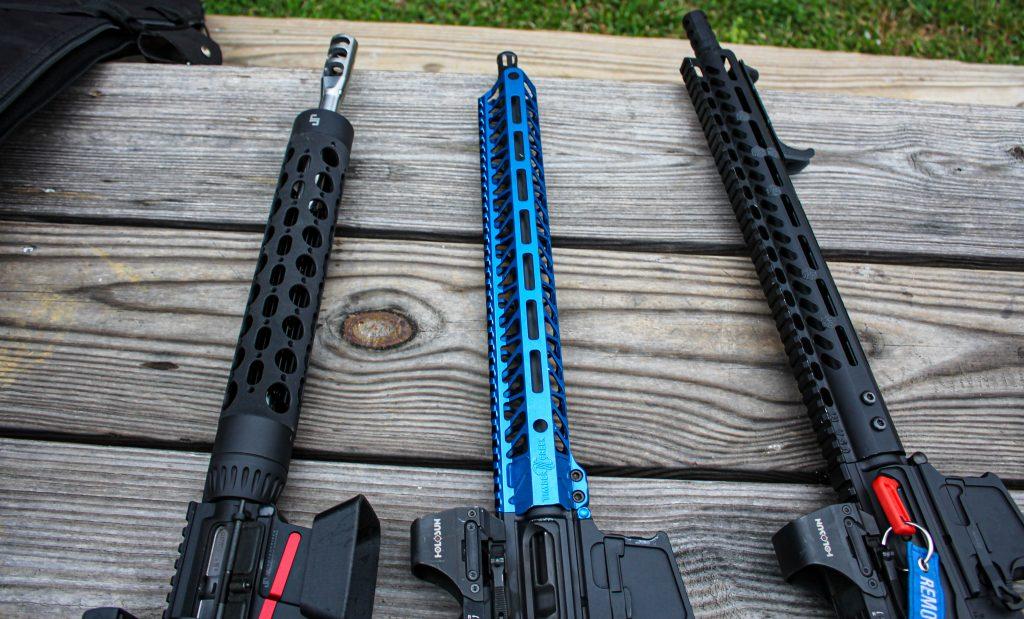
You must choose a handguard length that makes sense with the length of the barrel you choose. Your hand should never come into contact with or grip your barrel, which is where handguards come in. There are two types of handguards, free-floating and fixed.
A free-floating handguard is directly mounted to the upper receiver. It’s essentially a long tube that never touches the barrel.
The accuracy of a barrel can easily be impacted if anything touches or comes in contact with it while firing. That’s what makes the free-floating handguards so popular. They also can be longer than the length of the gas system when using a low-profile gas block, extended the useful area of the guard.
A fixed handguard is usually not so fixed. These handguards are held in place by the delta ring and the plate behind your front sight post. If there’s any wear on the delta ring, these handguards can tend to move around — and even the smallest bit of movement can impact your ballistics.
When it comes to a rail system, you need to envision your setup before making a choice. If your AR pistol needs an optic on top, a backup optic on one side, a laser on another side with a flashlight, you may need a quad rail system to mount everything on it.
For most free-floating handguards, they use either a Picatinny rail, M-Lok, or Key Mod. These are different designs for mounting hardware. Key Mod looks like keyholes, for example, which is how it got its name. One isn’t necessarily better than the other, so much as your optics, lasers, lights, etc., have to match the rail mounting system to be compatible.
7. Muzzle Devices
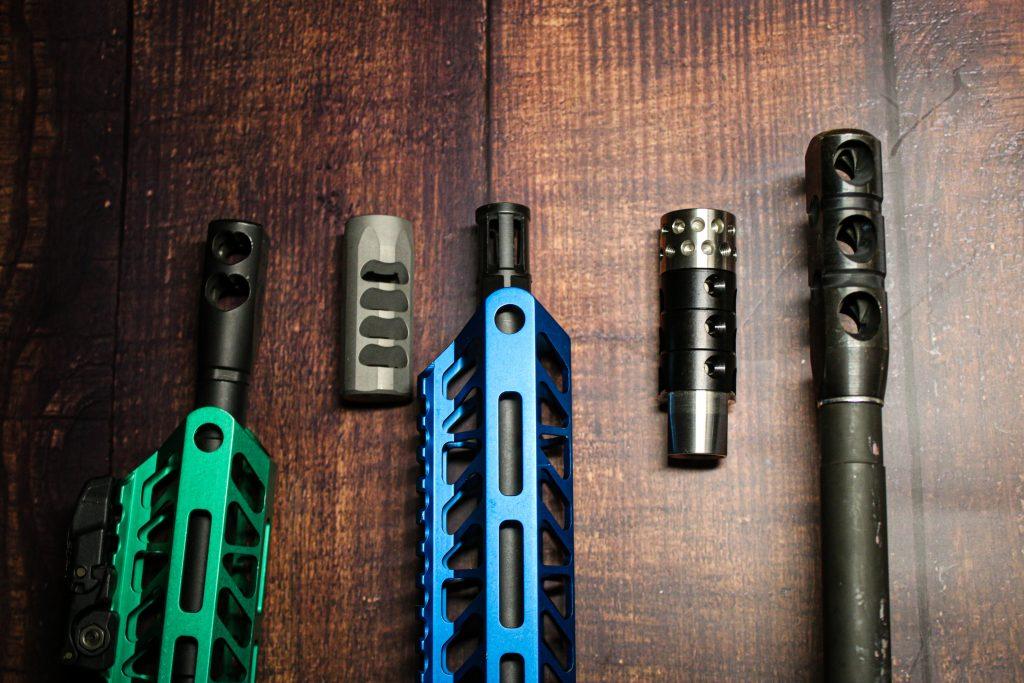
Muzzle devices are used for a variety of reasons. They can direct gas outward to decrease blowback, muzzle rise, and recoil. They can act as flash hiders. A quality muzzle device will direct the gas outward evenly to prevent moving the gun in any one direction, allowing the shooter to make a more accurate follow-up shot.
A muzzle brake is more commonly used as a gas diverter and to lower felt recoil. Flash hiders were built to reduce the visible signature while firing by cooling the gases that exit the muzzle.
8. Triggers
Picking out a trigger is a personal preference and also a skill/safety check. Triggers can come in a two-stage configuration or single stage. A two-stage trigger has two stages – the take-up stage and the wall stage.
A single-stage trigger has one consistent pull for the entire trigger pull. Single-stage triggers are used more in competitive landscapes. Because they are so lightly set up, they can cause accidental discharges, especially in high-stress situations.
Again, triggers can also be flat or curved, a personal preference on what feels most natural to you.
Legal Considerations & ATF Compliance
At any given moment in time, this section could become obsolete as the ATF has either tried to or has made laws that affect the legality of AR pistols or their parts. The introduction of stabilizing braces revolutionized AR pistols, but the legal distinction remains murky.
Current Situation: As of January 2023, the ATF dropped their 293-page final rule on pistol stabilizing braces, which basically outlined that all braces, if they are fitted to an AR pistol, create a short-barreled rifle which needs to be registered correctly or the owner could be facing 10 years in federal prison. However, multiple lawsuits challenge this interpretation, creating a legal gray area.
There are an estimated 4-40 million braced pistol owners in the U.S., which are almost certainly going to support what will certainly be many, many lawsuits on this one once it hits the federal register.
Your Options:
- Register as SBR: Pay $200 tax stamp (waived during initial compliance period)
- Remove/destroy brace: Return to buffer tube only
- Install 16+ inch barrel: Convert to rifle configuration
- Surrender firearm: Turn in to local ATF office
- Destroy pistol: Permanent disposal
Reality Check: Many owners are taking a “wait and see” approach as courts determine the rule’s validity. Consult current legal resources and consider professional legal advice for your specific situation.
What are your options? The ATF outlines a few — such as destroying the pistol, registering it on an e-Form 1 during the 120-day window (they’ll waive the $200 tax stamp, how nice…), or removing (and destroying) the brace itself. You can also turn the firearm over to your local agent or slap on a 16+ inch barrel to turn that former pistol into a rifle.
Expect this topic to evolve as the ruling gets pressed in court.
State and Local Considerations
Federal law represents just one layer of regulation. State and local laws can be significantly more restrictive:
Common State Restrictions:
- Assault weapon bans affecting AR-pattern firearms
- Magazine capacity limits
- Registration requirements
- Transport and storage regulations
High-Restriction States: California, New York, Connecticut, and others have specific laws that may prohibit AR pistols entirely or require significant modifications.
Always verify local laws before purchasing. What’s federally legal may be prohibited in your jurisdiction. When in doubt, consult local law enforcement or firearms attorneys familiar with your area’s regulations.
Remember: Ignorance of the law isn’t a defense. The regulatory landscape changes frequently, and staying informed protects both you and your investment in these firearms.
AR Pistol Types & Applications
.223/5.56 NATO Pistols
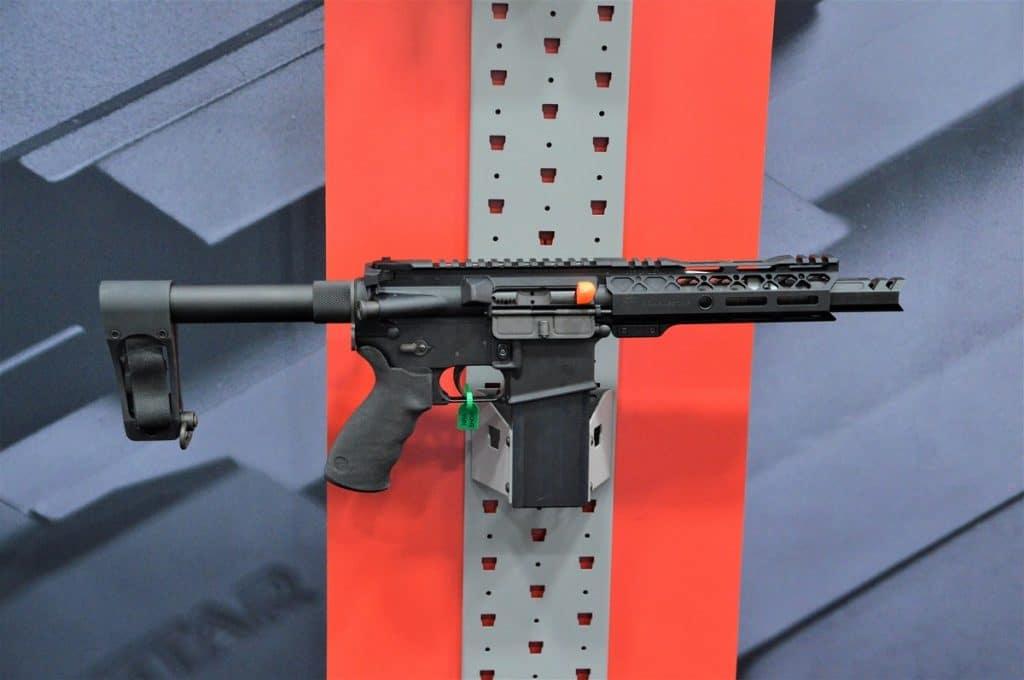
The first are those that come in the standard AR-15 cartridge. With a 10″ barrel chambered in 5.56mm NATO, this round is still effective out to about two hundred yards, but the AR pistol’s short barrel somewhat hinders the cartridge’s performance.
Your AR pistol will likely not be the most accurate long-range gun in your collection, but if you want a close-up weapon, they can be a great option.
Pistol Caliber Carbines (9mm): The Training-Friendly Option
Second and increasingly popular are those AR pistols with calibers other than 5.56mm. The most popular one here is 9mm, often accepting Glock magazines or something similar.
9mm AR pistols offer several compelling advantages: cheaper ammunition, reduced recoil, and often compatibility with pistol magazines you already own. The lower-powered cartridge is gentler on indoor ranges and makes extended training sessions more comfortable.
These make excellent suppressor hosts, and many folks use them for self-defense or as their long gun for shooting competitions. One of the primary benefits here is that these can often be planned out to share a magazine with your pistol, which makes logistics and reloading much more straightforward, especially in home defense scenarios.
Best For: Competition shooters, training applications, or those wanting to share magazines between pistol and long gun.
Trade-offs: Limited range and terminal effectiveness compared to rifle cartridges.
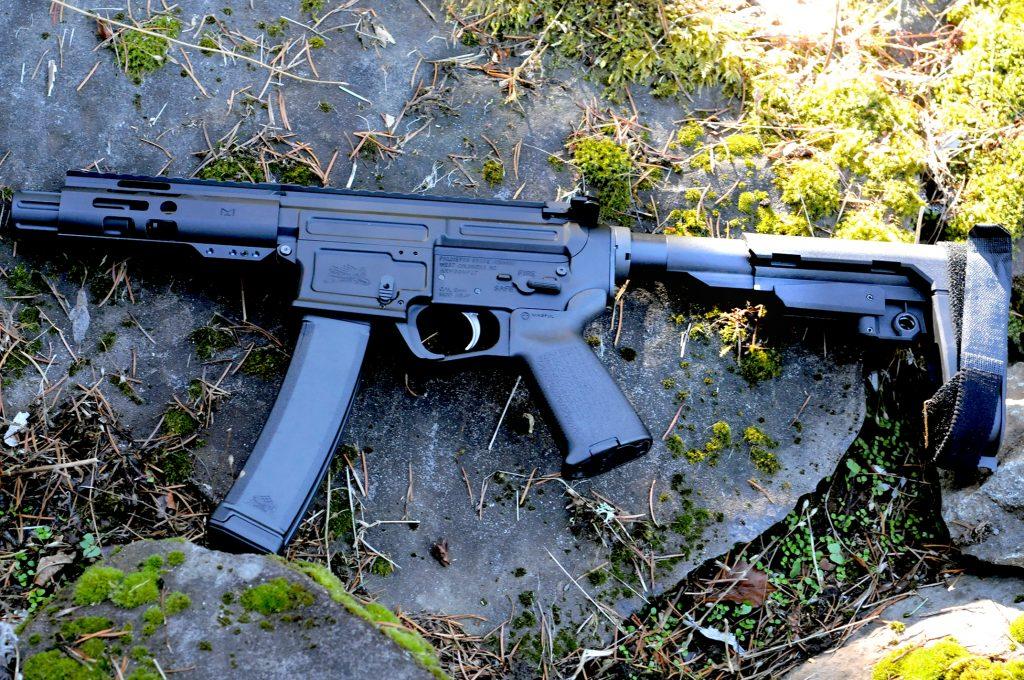
Specialty Calibers: Beyond The Usual Cast of Characters
While 5.56/.223 dominates the AR pistol market, specialty calibers offer unique advantages for specific applications. Understanding these alternatives helps you choose the right tool for your particular needs.
.300 Blackout: The Subsonic Specialist
Designed specifically for short barrels, .300 Blackout shines in AR pistols. Unlike 5.56, which loses significant velocity in short tubes, .300 BLK maintains effectiveness down to 7-8 inches. Subsonic loads paired with suppressors create an exceptionally quiet package, while supersonic loads deliver serious terminal performance.
Best For: Suppressor users, hunters requiring discretion, or those prioritizing maximum effectiveness from ultra-short barrels.
Trade-offs: Higher ammunition costs and limited range compared to 5.56.
Other Specialty Options
- .45 ACP: Maximum stopping power in pistol calibers, but limited capacity and range
- 6.5 Grendel: Extended range capability in AR pistol format, though uncommon
- 6.8 SPC: Military development round offering improved terminal ballistics over 5.56
Caliber Selection Reality Check
Before jumping to specialty calibers, honestly assess your needs. Most shooters are best served by 5.56/.223 for its versatility, ammunition availability, and proven performance. Specialty calibers excel in specific roles but shouldn’t be your first AR pistol unless you have a clear, defined need they address.
The Barrett REC7 DI in our reviews exemplifies proper .300 Blackout application – premium components optimized for the cartridge’s strengths rather than a simple barrel swap on a 5.56 platform.
DI Pistols
Most AR 15 pistols will use Eugene Stoner’s original AR design, a direct gas impingement system. While these tend to run a little dirtier than the other gas systems out there, they are immensely reliable with quality ammunition.
In an AR pistol, though, full-powered 5.56mm has a lot of gas left to burn off at the end of a 10” barrel, and a fair bit of it is likely to end up back in the action, which tends to slightly over-gas these pistols. But, with that said, as long as you replace the buffer spring every few years and keep an eye on any excess wear, this is not usually an issue for most users.
What about AK Pistols?
Some AR pistols run with some variant of a gas-piston system of the type more commonly found in the AK series of rifles. This has one major advantage for pistols: the excess gas gets vented early in the firing sequence and thus does not end up back in the action. It does mean a few different or extra parts to keep an eye on, but gas piston systems are also extremely reliable and work well.
Which system you choose is primarily a matter of personal preference or the desire to try something new.
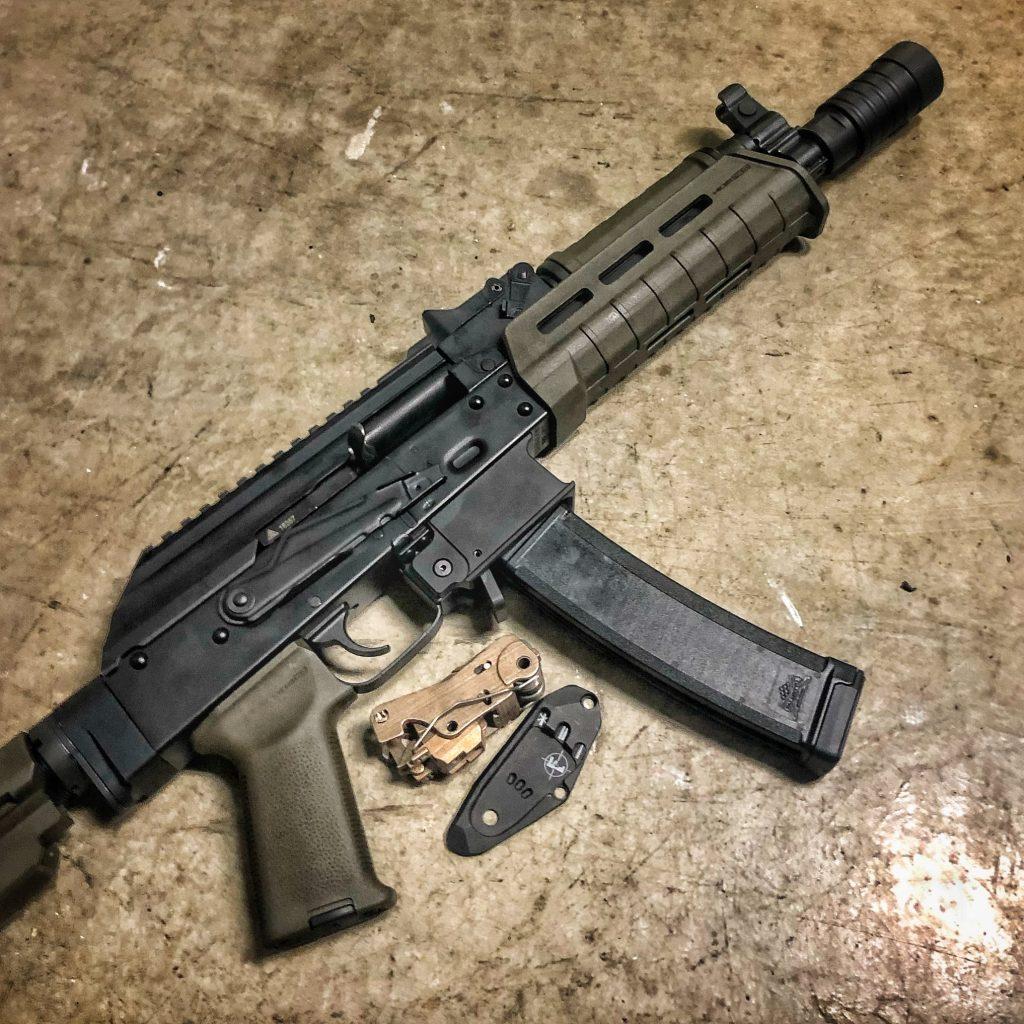
Historical Context & Evolution
With the AR-15 commonly described as “America’s Rifle,” the more recently introduced pistol variant of the iconic firearm is rapidly gaining attention, making selecting a good one from the now-crowded field a challenge.
Pistol ARs give you more mobility, a lighter package, and an arguably more capable close-quarters platform than the traditional AR rifle. There’s no single best option, so what you’ll want will depend on how you intend to use the gun, your budget, and what you’re ultimately looking for in your new pistola.
Nonetheless, if you keep a few things in mind, the choices soon become easy.
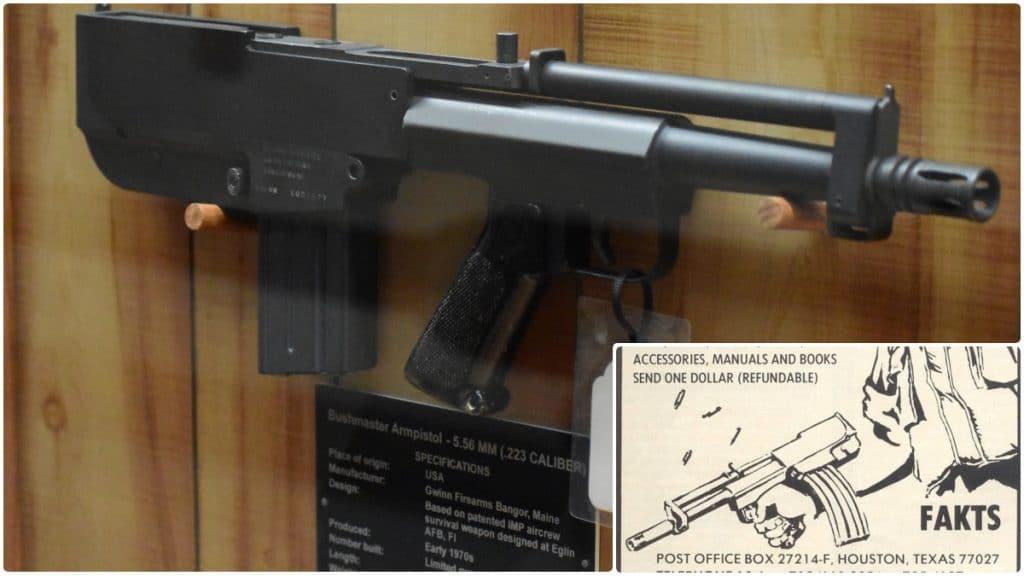
While the AR-15 series of carbines, a product of Fairchild Aircraft’s ArmaLite subsidiary, have been around since 1957, the AR-style handgun is a much more recent animal. In fact, the AR-15 existed for three decades before a semi-practical version of the gun in pistol format first gained real traction on the consumer market.
The original circa 1963 Colt SP-1/R6000, with its 20-inch barrel and 40-inch overall length, almost was instantly supplemented by the R6001 Carbine with a shorter 16-inch barrel.
Likewise, the military sliced their standard 39.5-inch M16 rifle first to the more compact Vietnam-era XM177E1, then to the M4 which used both a shorter barrel and a collapsible buttstock, to drop the length down to 29.5-inches.
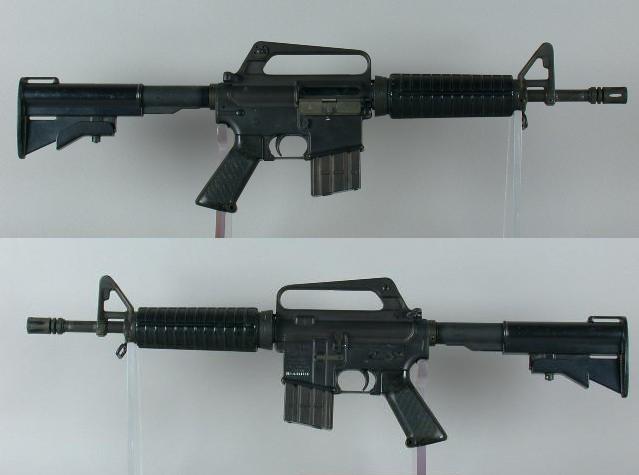
While the Gwinn/Bushmaster 5.56mm NATO “Armpistol,” a compact 20-inch-long bullpup handgun that utilized some AR-15 parts was around back in the early 1970s and made rifle calibers available in a large-format pistol, its internals were pretty far from being that of the Eugene Stoner’s original ArmaLite work.
By 1986, the Australian Automatic Arms Corp, based in Tasmania, was exporting their SAP pistol to the U.S., an AR-15-ish handgun with a fiberglass receiver and forearm along with a 10.5-inch barrel.
An American AR Pistol
The first American-made AR pistols debuted in 1993, the Rocky Mountain Arms Patriot and the Olympic Arms OA93, the latter of which going on to live in gun culture forever, as being used the same year by William Dafoe as CIA super spook John Clark in the film Clear and Present Danger.
Unfortunately, the 1994 Federal Assault Weapon Ban largely froze commercial AR-15 development for a decade from 1994 until it expired in 2004.
Expiration of the Federal Ban Helps the Pistol Market
However, once the federal ban went the way of the dinosaurs, the market began to voraciously expand, with the 20 or so AR-15 rifle makers in 2005 growing to over 200 today.
Still, while Olympic Arms rebooted their OA-93 and new pistols such as the Bushmaster Carbon 15P and Hesse HAR-15 began to circulate, it was the initiative of firearms giant Sig Sauer that broke the mold and took the AR-15 handgun mainstream by introducing their P556 in 2009, later adding their P516 to the lineup in 2011.
Then, Sig introduced a serious game-changer.
In 2013, Sig Sauer debuted their PM400 series AR-15 pistol complete with the SIGTac SB15 Stabilizing Brace billed as being able to “Dramatically improve the single-handed performance of buffer tube equipped pistols.”
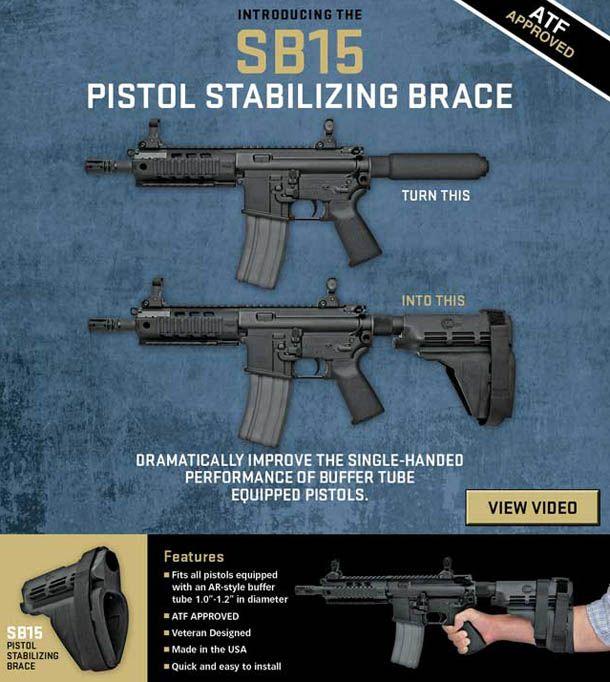
Not a Stock, No Paperwork
Patented by Alessandro Bosco of SB-Tactical, the Sig Brace was blessed by the ATF as not being legally a “stock” thus avoiding changing such handguns it was attached to into a short-barreled rifle, which would require a tax stamp and NFA (National Firearms Act) paperwork.
Such stabilizing braces and follow-on models like the KAK Blade, SBA3, Gearhead Tailhook, and others have continued to evolve the AR-15 pistol market, allowing essentially a “poor man’s SBR” without the hassles of extra ATF paperwork or crossing any National Firearms Act boundaries that are concerned with things like a rifle stock.
The Brace Market Explodes
The appeal of these new braced pistols kicked off a surge in demand and by 2019 more than 50 gun makers were cranking out an AR-pattern handgun including big names like ArmaLite, Barrett, Daniel Defense, FN and Wilson Combat.
Nonetheless, keep in mind that AR pistols using just a buffer tube padded with just a simple foam sleeve or neoprene sock can still provide a decent cheek weld without having to be further supported except by the hands– while shaving a few inches overall length by not including a brace.
It is a solid shooting method for these guns that can prove very effective with practice but one that too many shooters, used to handling the AR-15 as a rifle and seeking firm shoulder support from a stock, fail to try.
Performance & Value Analysis
Under $1,000
For under $1000, it’s more than possible to find a good AR pistol. You’ll have a standard upper, lower, and trigger in this price range, and all of the parts will likely be standard military-spec.
This is a great place to start for most people, and you’ll probably end up buying a brace and optics on your own. Also, the handguard might be nothing fancy, and the pistol grip will likely be something fairly standard. AT this price point you’ll find brands like PSA, Radical Firearms, and Foxtrot Mike.
Over $1,000
For over $1000, you’ll start to see higher-end features as you’re willing to spend more. Some of the first things to get included here will be the pistol brace and an upgraded or free float handguard.
From there, the internals will likely be more feature-rich, such as a chrome-lined barrel or a more durable bolt carrier group. You can also expect to have things like optics included at the upper end of the price range, though this is uncommon even on higher-end models. Generally, ARs have gotten a bit more expensive in the past few years, which is no different for pistols.
Depending on your budget, though, you can certainly get into a decent AR pistol for under $1,000. You’ll see brands in this price range like Daniel Defense, CMMG Banshee, Barrett, the Sig Sauer MCX and Maxim Defense.
Value Categories Explained:
- Budget ($600-900): Great starting points, plan for upgrades
- Mid-Range ($900-1,500): Better out-of-box experience, fewer immediate needs
- Premium ($1,500+): Top-tier components, diminishing returns past $2,000
Here’s where your money goes and what you get for it when it comes to our recommendations:
| Model | Price Point | $/Performance | Upgrade Potential | Warranty | Best Use Case |
|---|---|---|---|---|---|
PSA PA-15 | Budget | Excellent | High | Lifetime | First AR pistol |
Daniel Defense MK18 | Premium | Good | Medium | Limited | Clone build/duty |
Springfield Saint | Mid-Range | Good | High | Limited | Truck gun |
Ruger AR-556 | Budget+ | Good | High | 1 Year | Brand loyalty |
BCM RECCE 11 | Upper-Mid | Excellent | Medium | Limited | Hard use |
Sig M400 Tread | Mid-Range | Good | High | Limited | Home defense |
Barrett REC7 | Premium | Fair | Low | Limited | .300 BLK specialist |
Diamondback DB15 | Budget | Good | High | Limited | Ultra-compact |
FN 5.56 | Upper-Mid | Good | Medium | Limited | Military connection |
Shortcomings
While AR pistols offer a lot of upsides, they’re designed to play a specific role in the firearms world. This means that they are better for certain applications than others.
Lack of ranged performance
A pistol being a pistol, you’re certainly not going to get accuracy much beyond 100 yards (or possibly a little more). If you want to reach out to 200, 300 yards or more, you’re better off picking up an AR-15 or bolt action rifle to get truly long-ranged performance with that longer barrel.
Limited calibers
Most rifle-caliber cartridges weren’t designed for the short-barreled world of AR pistols, which means they don’t achieve optimal ballistic performance in pistol-length barrels.
Some calibers are designed specifically for short-barreled performance (see: the .300 Blackout) but you simply won’t get the same breadth of caliber options with an AR pistol as you will with rifles.
Legal Considerations & ATF Compliance
The pistol brace is not without its fair share of controversy. The ATF has signaled to revisit the issue of brace legality, without actually changing policy or position.
This inconsistency can make it hard for people to determine if they’re on the wrong side of ATF policies, which makes navigating the world of AR pistols even more complicated than other firearms.
Far too many potential AR pistol owners jettison their research before gathering everything they need to make a purchase decision. Also, once you have an AR pistol registered with the ATF, that configuration is semi-permanent.
There is no swapping out lowers out once that lower is registered as a pistol. You’ve got a pistol for life.
More Resources
- ATF, Gun Control Act Definition – Pistol
- Congress.gov, 1994 Federal Assault Weapons Ban
- ATF, Rifles Configured from Pistols
- The Trace, Why the ATF canceled its review of Pistol Stabilizing Braces, March 30, 2021
Updated
June 11, 2025 — Major article restructuring with enhanced comparison tables covering barrel specs and performance metrics. Added comprehensive use case recommendations matching each pistol to specific applications.
Sign up for our newsletter
Get discounts from top brands and our latest reviews!





